There's more wildlife out and about in winter than you might think. Overwintering geese are arriving on our shores, full-grown fox cubs are leaving their family for the first time and Atlantic salmon are moving upstream to spawn. Get inspired to go outdoors by reading our top tips of which species to look out for this month and where to find them.
Turnstone (Arenaria interpres)
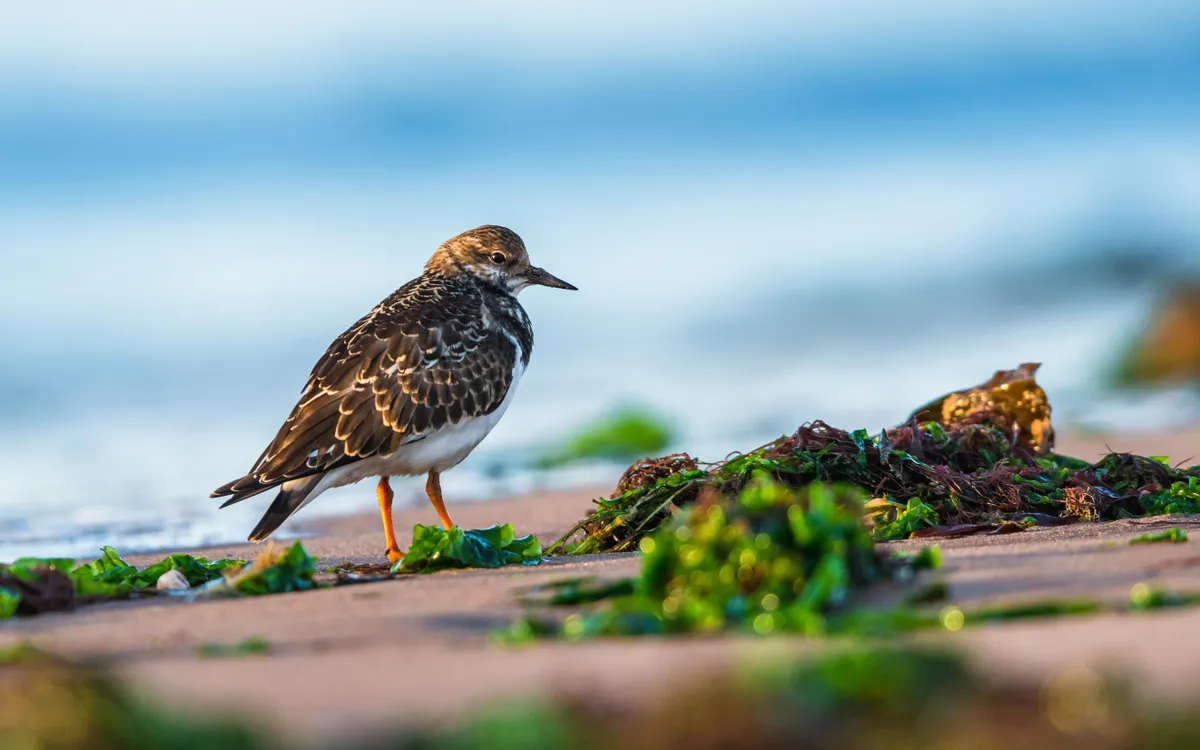
Beaches, much like lawns and road verges, fall victim to a peculiarly British obession with tidiness. Piles of seaweed along the strandline are seen as unsightly, so are cleared away, when in fact they represent a valuable habitat for species such as the turnstone, a chunky wading bird that does exactly what it says on the tin.
With a strong bill and neck adapted to stone-turning, it rummages through heaps of rotting seaweed like a bargain hunter ata jumble sale. Every now and again, the bird flips over a stone or bit of weed to reveal a sandhopper or some other tasty morsel – they eat insects, crustaceans and molluscs. The turnstone nests on Arctic coasts, with most of those wintering on British shores hailing from Greenland and northern Canada. Perhaps the lack of people in their breeding grounds explains why young birds especially can be incredibly tame, venturing close enough while foraging to be photographed with a smartphone.
Ivy (Hedera)

High in fat, ivy berries are an avian superfood. Weight for weight, the juicy, navy blue or black orbs are comparable to a bar of a well-known brand of chocolate, the RSPB says. No wonder birds love them. The berries appear between October and December, and don’t rot as quickly as most fruit, so are a useful food late in the year, when supplies of other berries have been exhausted.
The best crops of ivy berries are produced by older, mature plants, an excellent reason for allowing ivy to ramble to its heart content over trees and walls. If you see someone relentlessly hacking away at ivy, why not gently point out it is a favourite with birds? And not just birds – before the berries form, the ivy blossom provides nectar for late-flying butterflies and insects such as
ivy bees and hoverflies.
Learn more about how to help birds in winter:
Collared earthstar (Geastrum triplex)
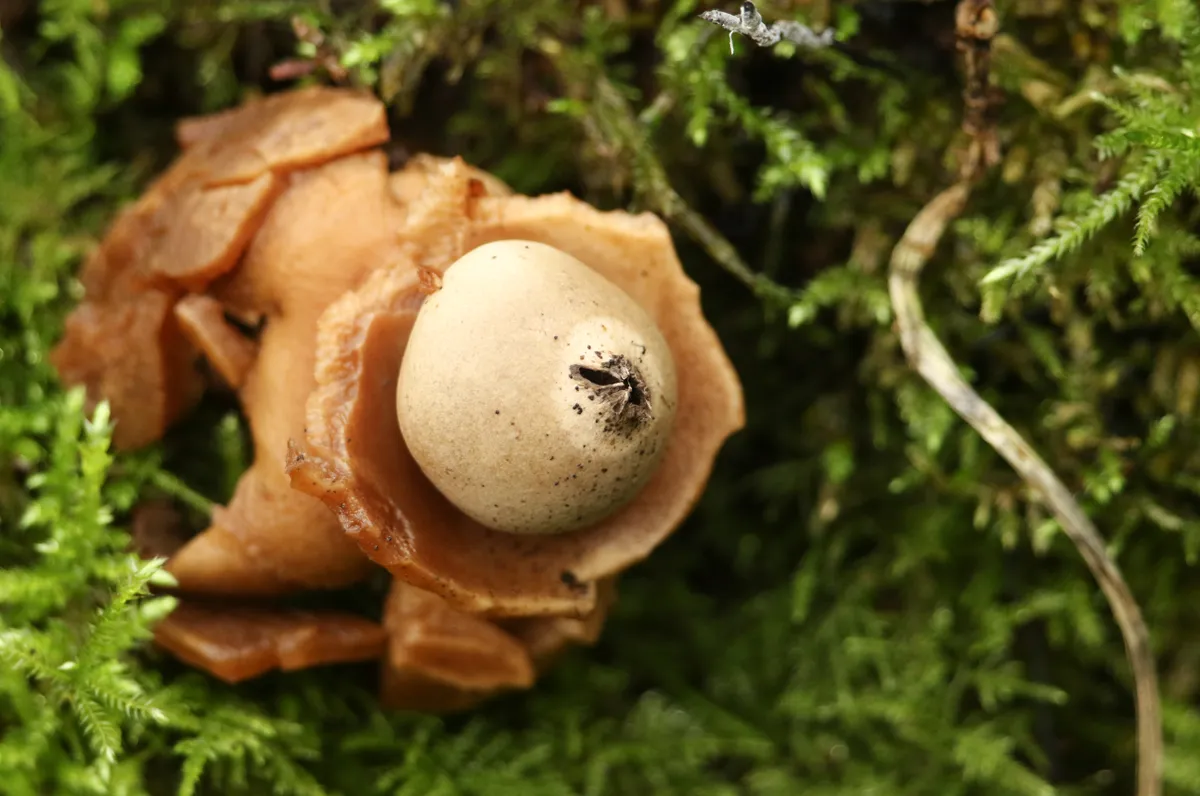
Some of Britain’s weirdest fungi erupt into our consciousness this month. Collared earthstars bide their time under the leaf litter in the form of vast numbers of fungal threads called hyphae. Now
they burst forth as onion-shaped fruiting bodies that soon split, the skin peeling back to expose a taut central dome. The slightest touch – rain, for example – releases the dust-like spores inside.
Jackdaw (Corvus monedula)
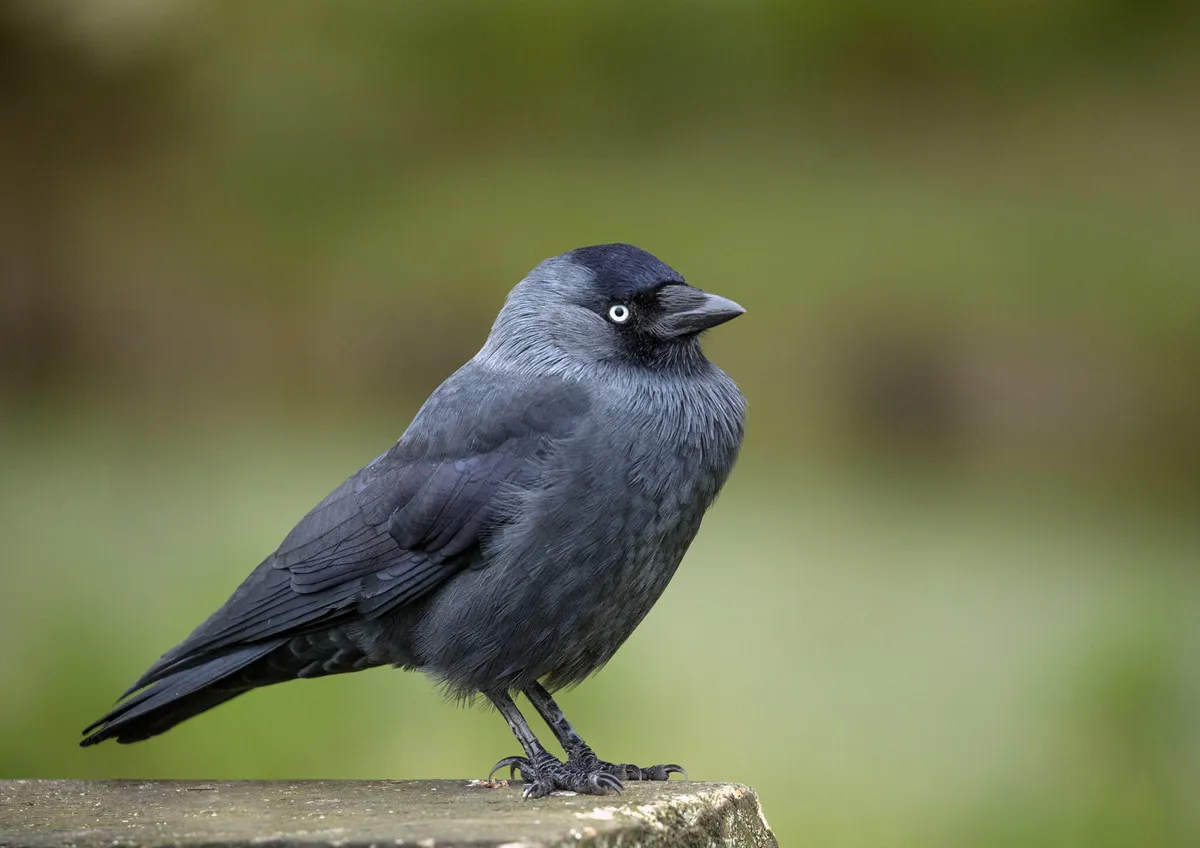
Jackdaws are interesting because they form unusually long-term partnerships. Once the pair bond is established, the male and female will stick together for years, even outside the breeding season.
If you watch a flock of jackdaws circling over a town or wood this month, you should be able to make out individual pairs within the larger group, just as you can with flocks of parrots in the tropics. The flocks make a wonderful winter spectacle, loved by many despite the volleys of shrill ‘kya-kya’ calls.
New research by a University of Exeter team studying jackdaw behaviour in Cornwall has found that these sociable crows use group vocalisation to work out when they should leave their communal roost each morning. To us, it may sound like a cacophany, but the researchers discovered this is actually a “democratic process” that determines precisely when the mass departure happens.
Ash (Fraxinus excelsior)
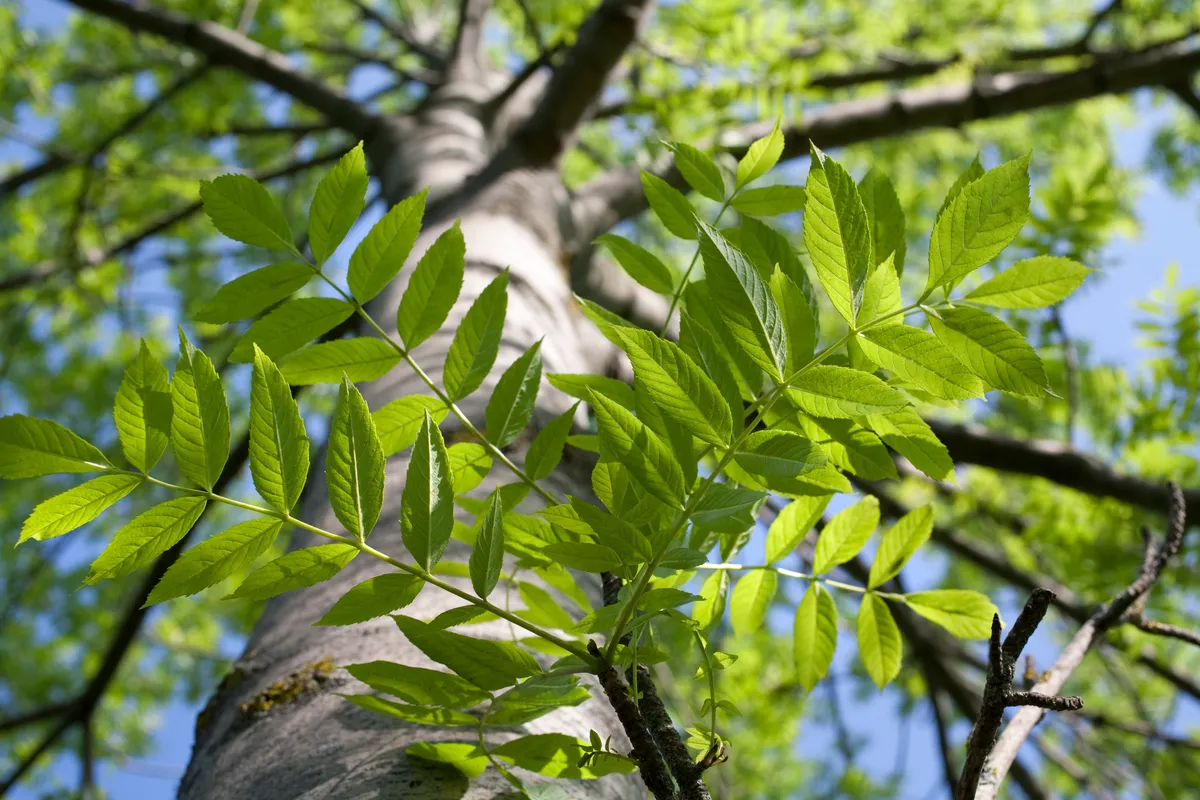
Ash is a tree that comes into leaf late, yet drops its foliage very early in the autumn, often when the leaves are still green or only just turning yellow. Its dangly fruits, which are flattened into wings and ripen to a coppery colour, are much in evidence by November. They hang in big bunches, known as keys, and these attract bullfinches that deftly extract the seeds inside. When they fall, wood mice are quick to gather them.
The late Oliver Rackham, in his 2014 monograph on the ash published the year he died, commented that there are nearly as many ash trees in the British Isles as people. But by that point, ash dieback disease, caused by the fungus Hymenoscyphus fraxineus, had arrived. It has since weakened and killed vast numbers of these tall and extremely useful trees, once worshipped by Vikings, widely coppiced and harvested for everything from ploughs to wheel rims.
Merlin (Falco columbarius)
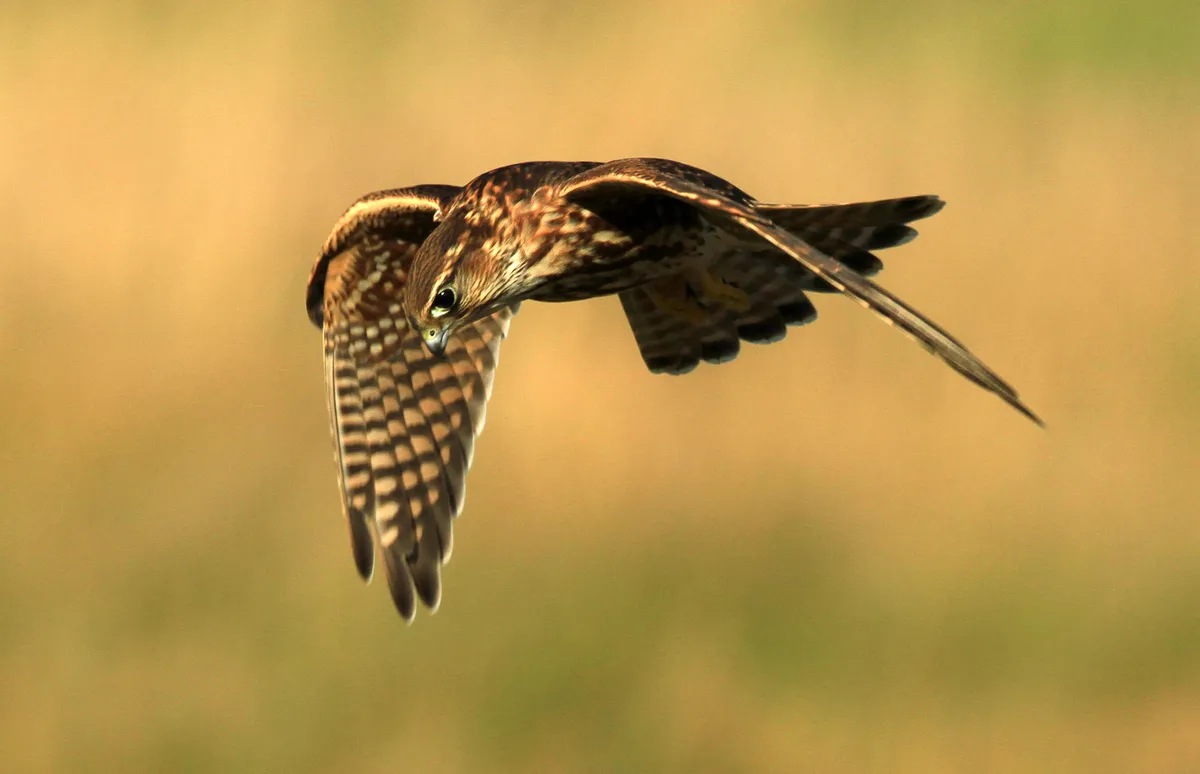
Merlins are scarce and mercurial birds. You can’t really predict when you’ll see one of these quicksilver falcons: they simply appear, often giving only a fleeting glimpse before vanishing into the distance.
In winter, however, the odds of a sighting are tipped slightly in your favour. While merlins spend spring and summer in our wildest and most remote upland areas, they move lower down after breeding. This means they can now be found on heaths, saltmarshes and arable farmland – anywhere with few trees and a wide horizon.
Merlins are the tiniest birds of prey in Britain and Ireland – kestrels are around a third larger, with a longer tail – but nonetheless pack a punch.
It’s perhaps best to think of them as miniature peregrines because, like peregrines, they target birds rather than mammals and neither hover nor take prey on the ground. Their signature hunting style is a high-speed aerial pursuit, skimming low over the ground. Between hunts, they perch and scan for prey.
Naturally, given their modest size, these pocket rockets go after small quarry, mostly pipits, larks, finches and buntings.
Ring-necked parakeet (Psittacula krameri)
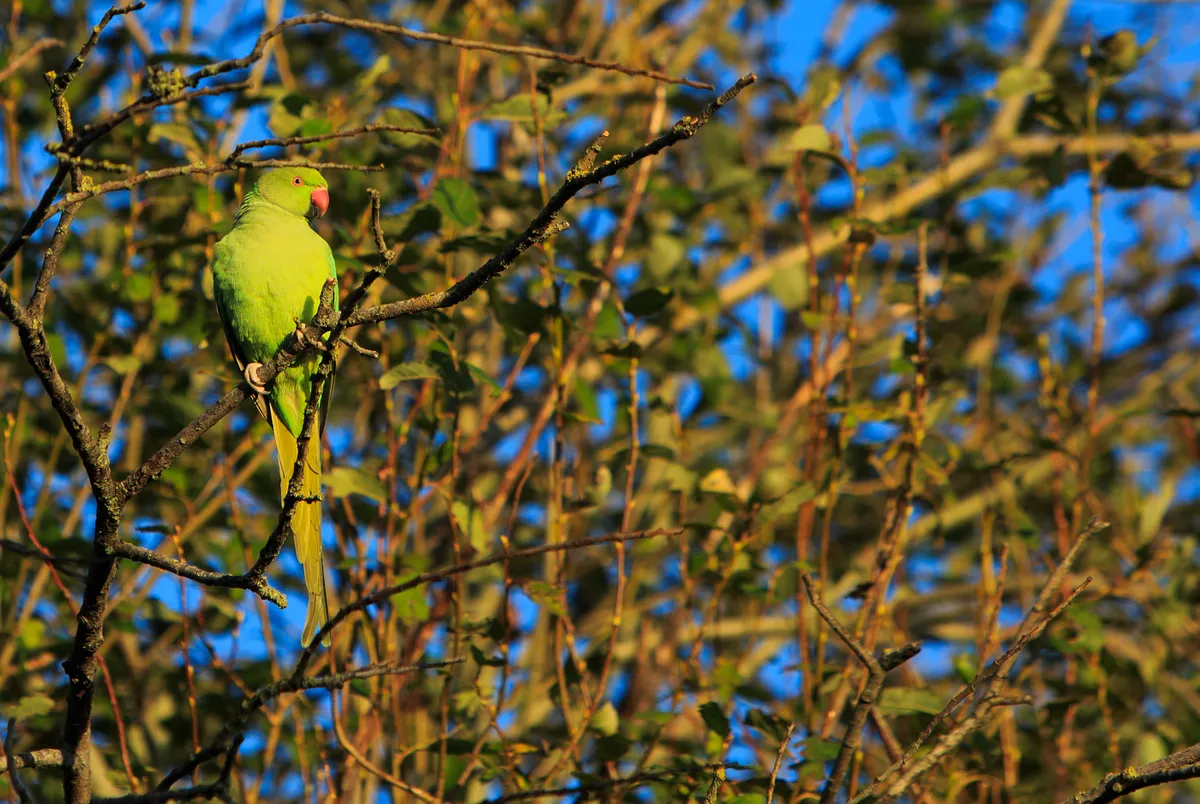
Originally from the Indian subcontinent, these brash birds are highly social, a habit they have retained wherever they have escaped from captivity and spread. They roost communally in tall trees such as poplars in UK cities from London to Edinburgh and Glasgow, now home to some of the northernmost free-flying parakeets in the world.
The parakeets return to the same location each evening, and over the years have favoured parks and cemeteries, rugby clubs and railway sides. There’s no mistaking these noisy treetop meetings. As Lev Parikian observes in his nature diary Light Rains Sometimes Fall: “Parakeets don’t do calm. There’s always something going on.”
The colourful gatherings are largest between September and November, after the breeding season. From November onwards, pairs begin to peel off from the main roost to choose a nest site in a hollow tree, which they sleep near. As early as January, some will be on eggs.
Learn more about non-native species:
European spindle (Euonymus europaeus)
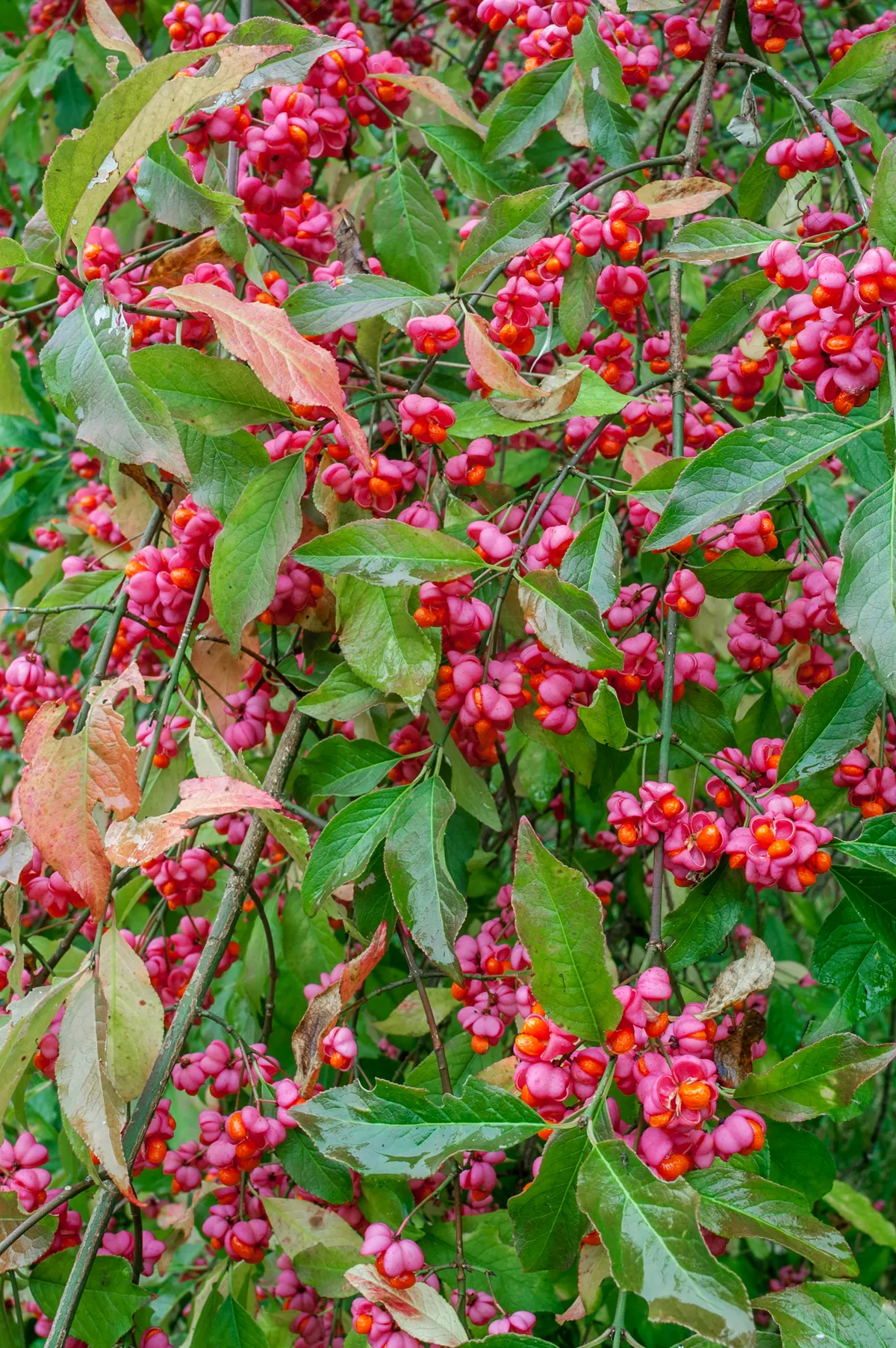
For most of the year, this small native tree is not much to look at. It is easily overlooked in hedges and scrubby woodland, unnoticed among the more obvious and straightforwardly identified trees such as hawthorn, blackthorn, field maple and ash. In autumn, however, spindle comes into its own. Its foliage turns a deep red, but the real attraction is its beautiful fruit.
Spindle berries are bubblegum-pink, a lipstick shade that seems almost shockingly bright in an autumnal British hedgerow. Each berry has four lobes, which when ripe burst open to reveal an orange ‘seed’. Strictly speaking, the real seed is hidden inside: the orange part is a soft covering known as an aril. Botanical technicalities aside, the orange-pink colour clash is spectacular. A few birds, such as blackbirds and robins, adore eating the berries, but they take care to reject or bring up the poisonous seeds.
Barnacle goose (Branta leucopsis)
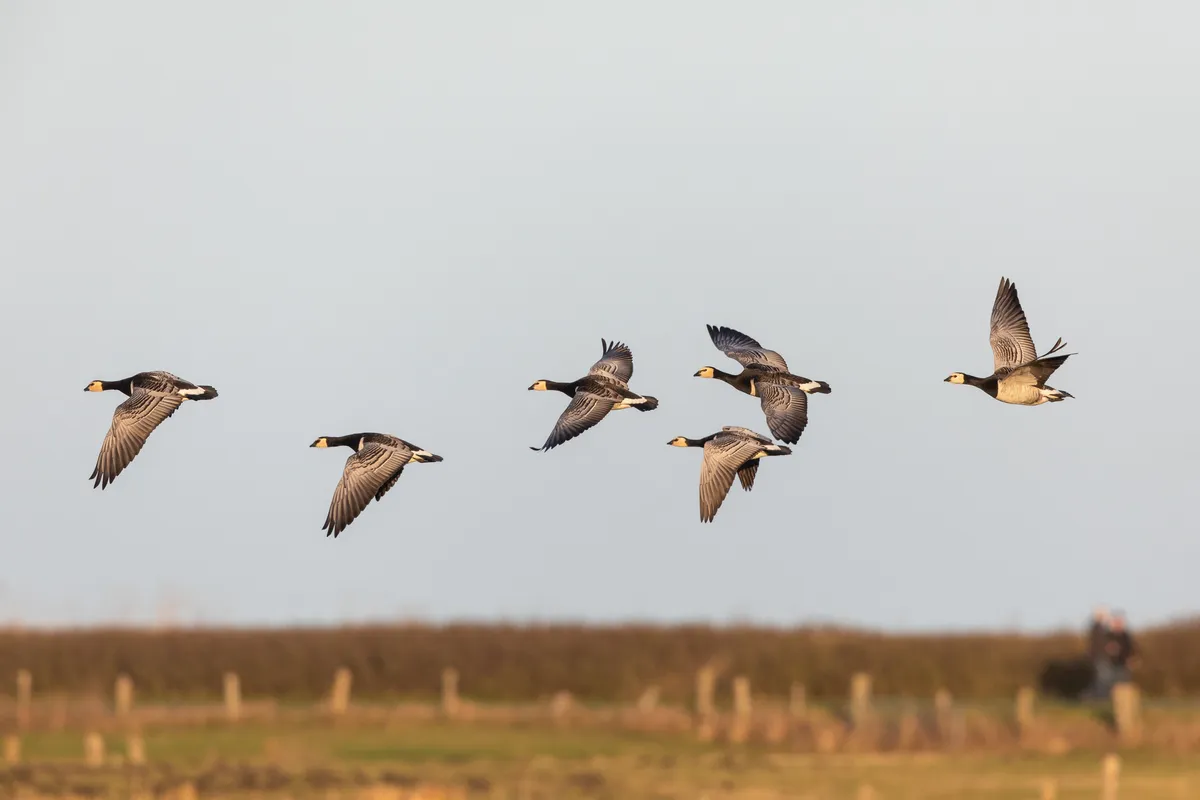
Vast numbers of barnacle geese flock to the mild coasts of Ireland, Scotland and north-west England for the winter. Twice a day until April, their great skeins commute between grazing areas inland and fox-free roost sites on coastal mud flats or shallows. The wild hubbub of their terrier-like yaps sends shivers down the spine of anyone lucky enough to be there.
Fly agaric (Amanita muscaria)
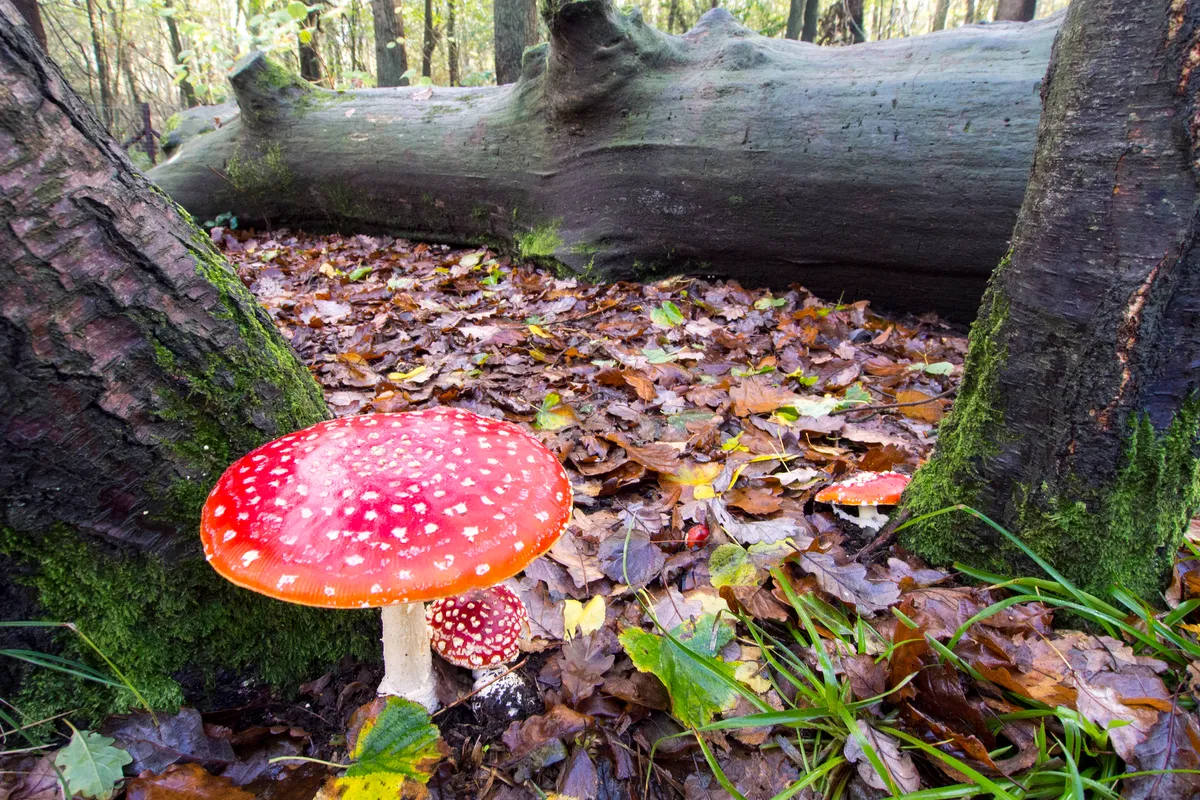
“The difference between animals and fungi is simple,” says mycologist Merlin Sheldrake in his book Entangled Life. “Animals put food in their bodies, whereas fungi put their bodies in the food.”
Fly agaric merges with pine and silver birch trees underground, extracting sugars from their roots via its fungal threads called hyphae. In return, it delivers nutrients from the earth. A perfect partnership.
Hibernating bats
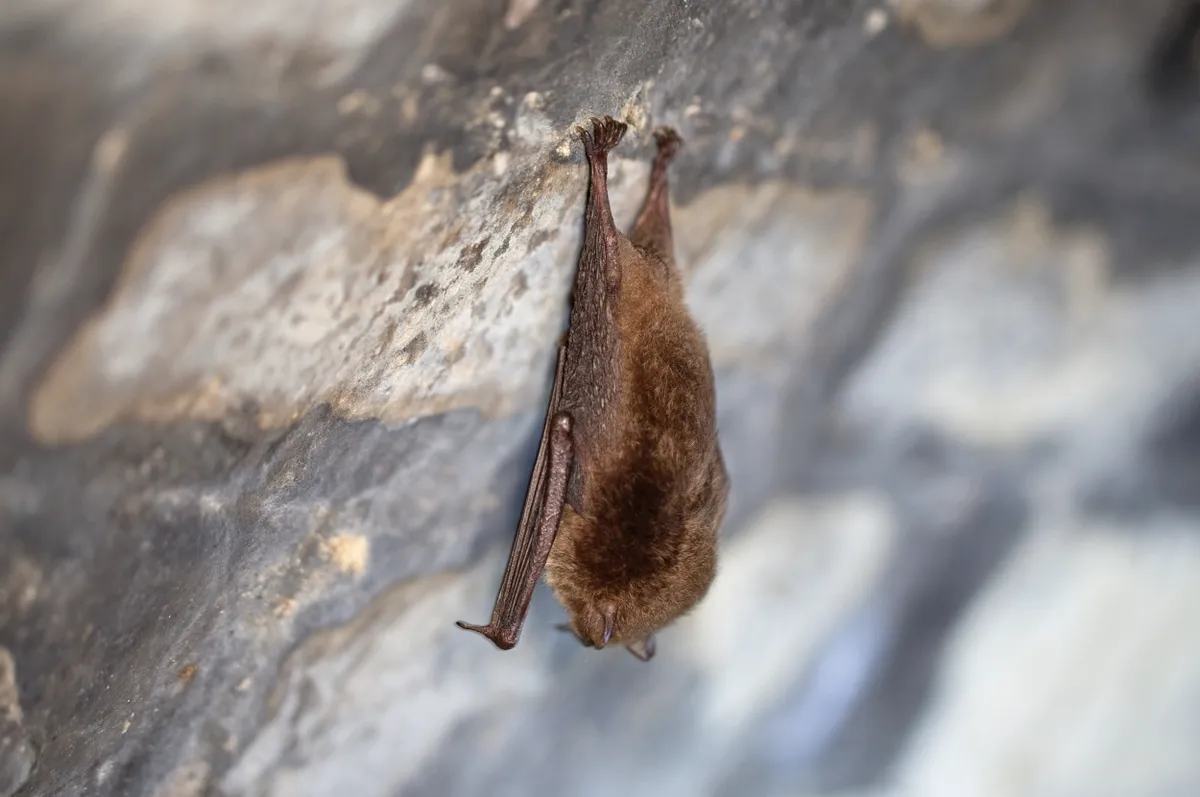
Insect-eating bats can’t cope with the lack of prey in temperate regions in winter, so feed intensively then hibernate, surviving off their fat reserves. In the British Isles, they fall into a deep sleep, or torpor, as early as October, with hibernation proper starting in November and December. A hibernating bat feels cold to the touch, because its body temperature has fallen as low as 7–8°C, from a normal resting level only a few degrees below that of humans.
Bats don’t usually breed and hibernate in the same place. Hibernation roosts, called hibernacula, need to be cool and dry, with a stable environment, and in autumn bats travel to find a suitably reliable site. This may be a short way away, but there is growing interest in bat migration. There’s evidence that some noctules and soprano and Nathusius’ pipistrelles move longer distances and perhaps overseas to continental Europe.
Purple sandpiper (Calidris maritima)
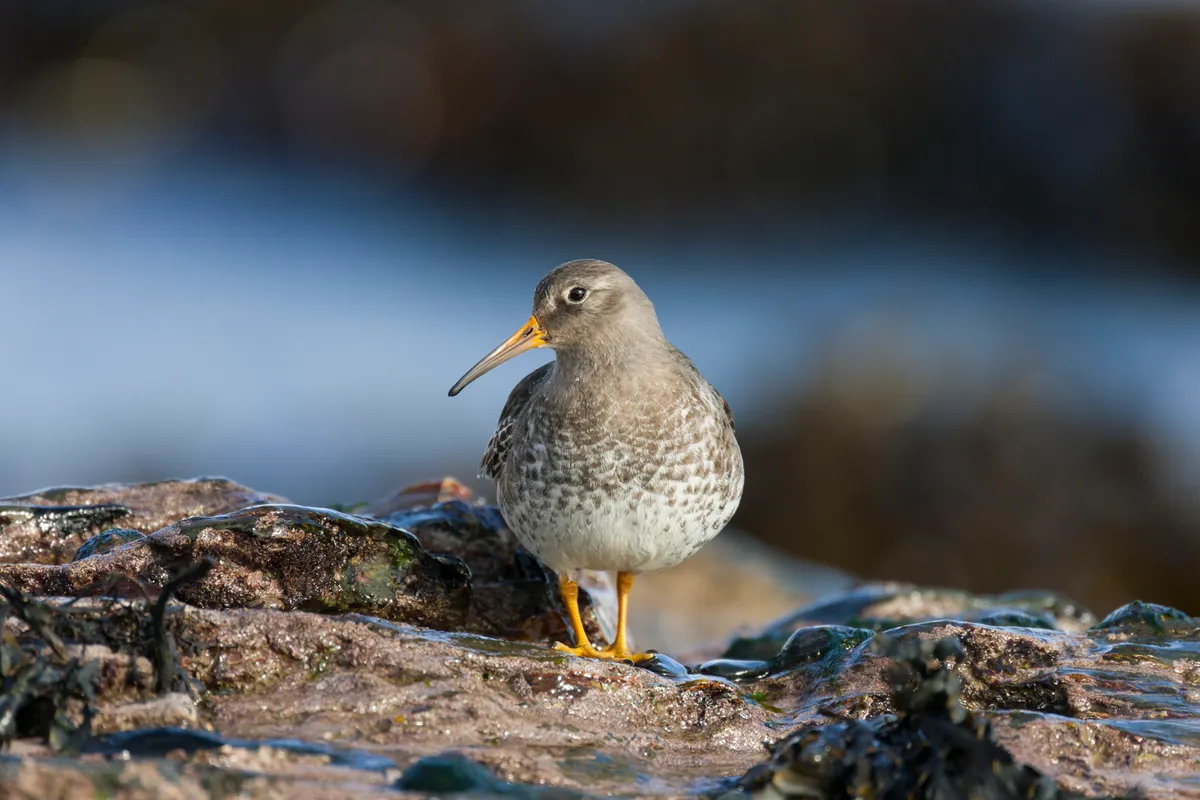
Clinging to seaweedy rocks just centimetres from the spume, as pounding waves crash around them, purple sandpipers have a good claim to be some of the toughest of all shorebirds. They spend the autumn and winter on Britain and Ireland’s most exposed coasts, braving whatever storms throw at them. Breakwaters, piers and jetties suit them too, but you’ll never see them on more sheltered mudflats and salt-marshes where most other wading birds are. They’re in their element amid the foam and spray.
Purple sandpipers are really warm grey, at least in non-breeding plumage. Any purplish sheen to their plumage is subtle, and most noticeable in spring and summer, which they spend on tundra and mountains in Iceland, Scandinavia and across the Arctic. Look for small groups of these tough cookies hunting marine snails and other invertebrates among the wet seaweed, flicking over the fronds to find their prey.
Red fox (Vulpes vulpes)
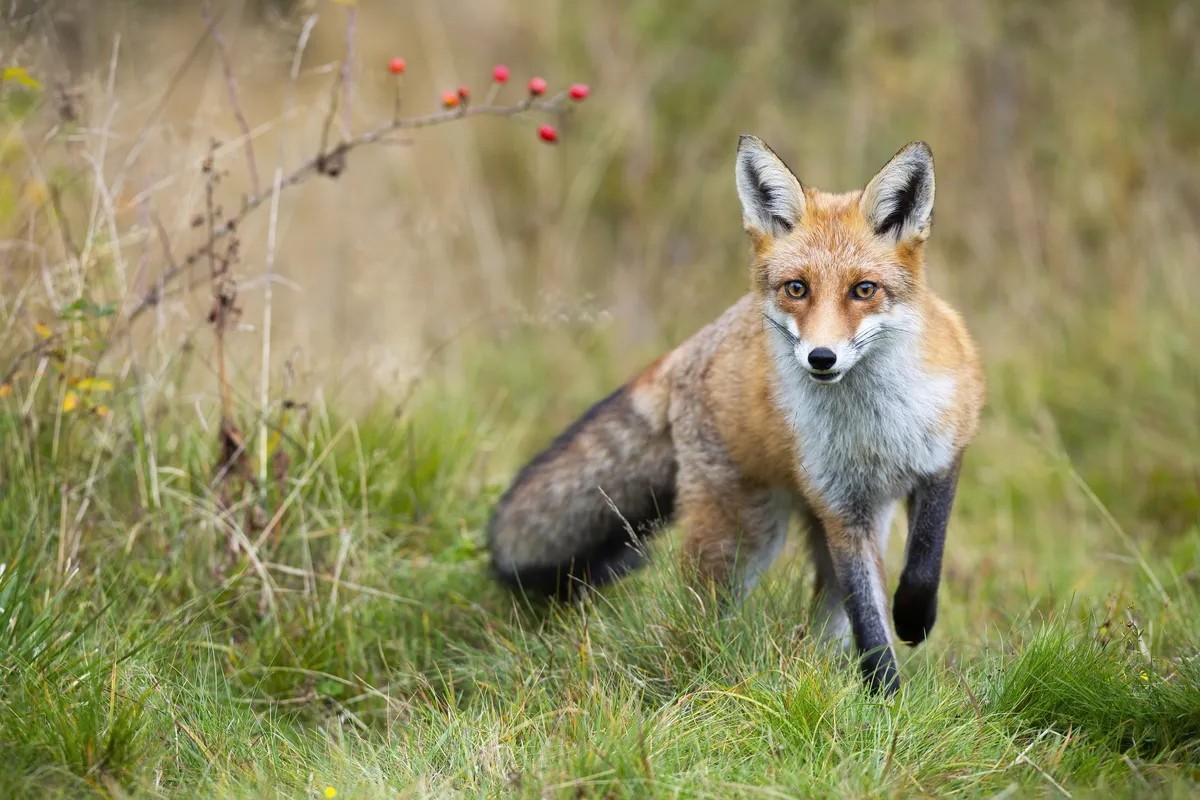
Breaking up is hard to do, but autumn signals a big change in fox family life, as the full-grown cubs leave the comforting surroundings of the vixen’s earth. Since birth they have been protected and fed by their parents, and in many cases, one or more adults known as subordinates help too. However, for a couple of months the youngsters have been exploring further afield.
Now comes the final break, when they wander off in search of their own territories and partners. Mammal ecologist Adele Brand explains in The Hidden World of the Fox: “As the shorter nights arrive, so do vulpine hormones.”
Brand cites a US study which found that young foxes disperse further and earlier the heavier they are, perhaps because they have more fat reserves and come off better in scraps. Males also tend to travel more, driven by the urge to mate. But the foxes do not necessarily go far, Brand says, particularly in places with lots of foxes. Some will never have a territory or young of their own: instead, they become subordinates and help a dominant pair.
Atlantic salmon (Salmo salar)
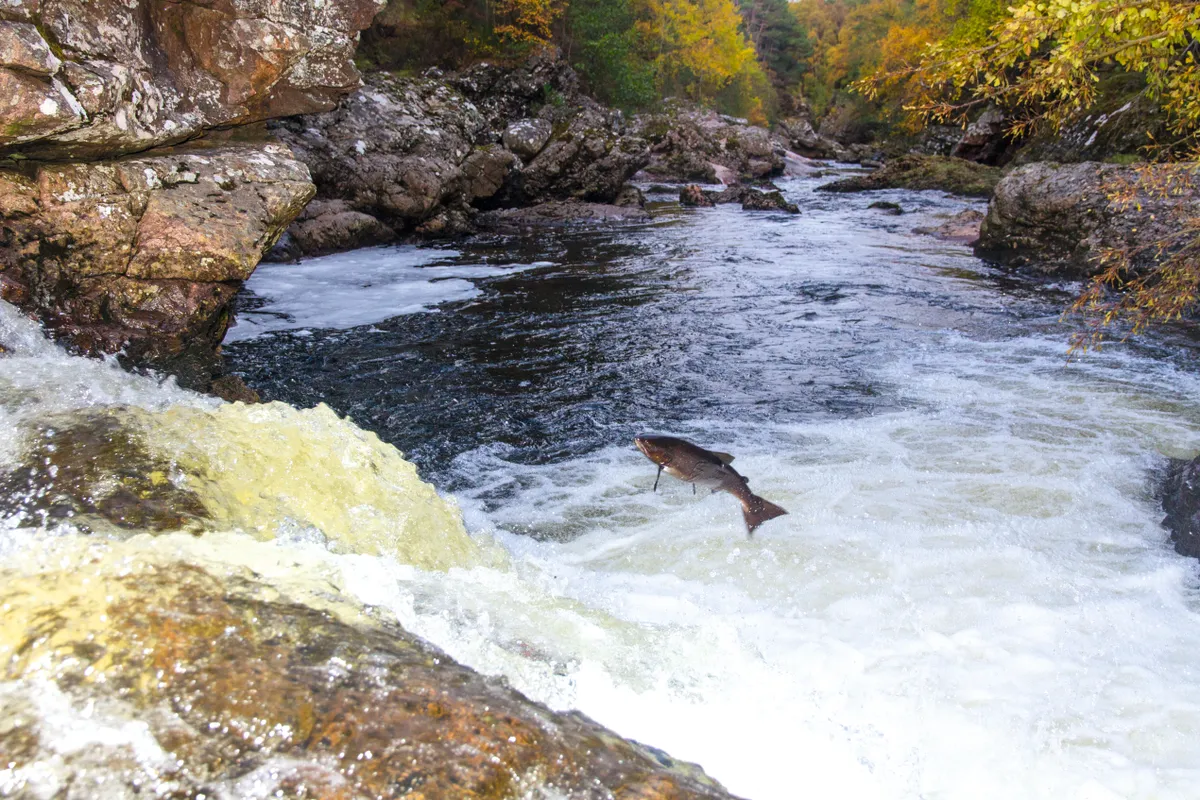
Surging rivers in northern Britain, Wales and Ireland, swollen with autumn rain, witness one of our greatest wildlife dramas. Rising water levels are a cue for Atlantic salmon to move upstream – traditionally between September and December – the penultimate stage in an odyssey whose climax is spawning.
These fish are the handful of survivors that dodged bigger mouths and fishing fleets to grow strong in cold Arctic waters, as far north as Greenland and the Barents Sea, a fabulously rich region, which writer Charles Rangeley-Wilson has called the “Harrod’s food hall of the oceans”.
After several years here, many salmon return to their natal river catchment, even the same part of it. Maybe they are guided by magnetic particles in the ‘lateral line’ along each flank, which might serve as a compass.
The famous salmon’s leap isn’t easy to observe. The fish may move after dark, lying low in shady parts of the river until conditions are just right, and salmon numbers in the British Isles have crashed in recent decades. But with repeat visits, a smidgen of luck and armed with local knowledge – ask anglers or river wardens, if you see them, or try one of the salmon viewing centres in Scotland – you’re in for a treat.
Learn more about salmon in the UK:
Pochard (Aythya ferina)
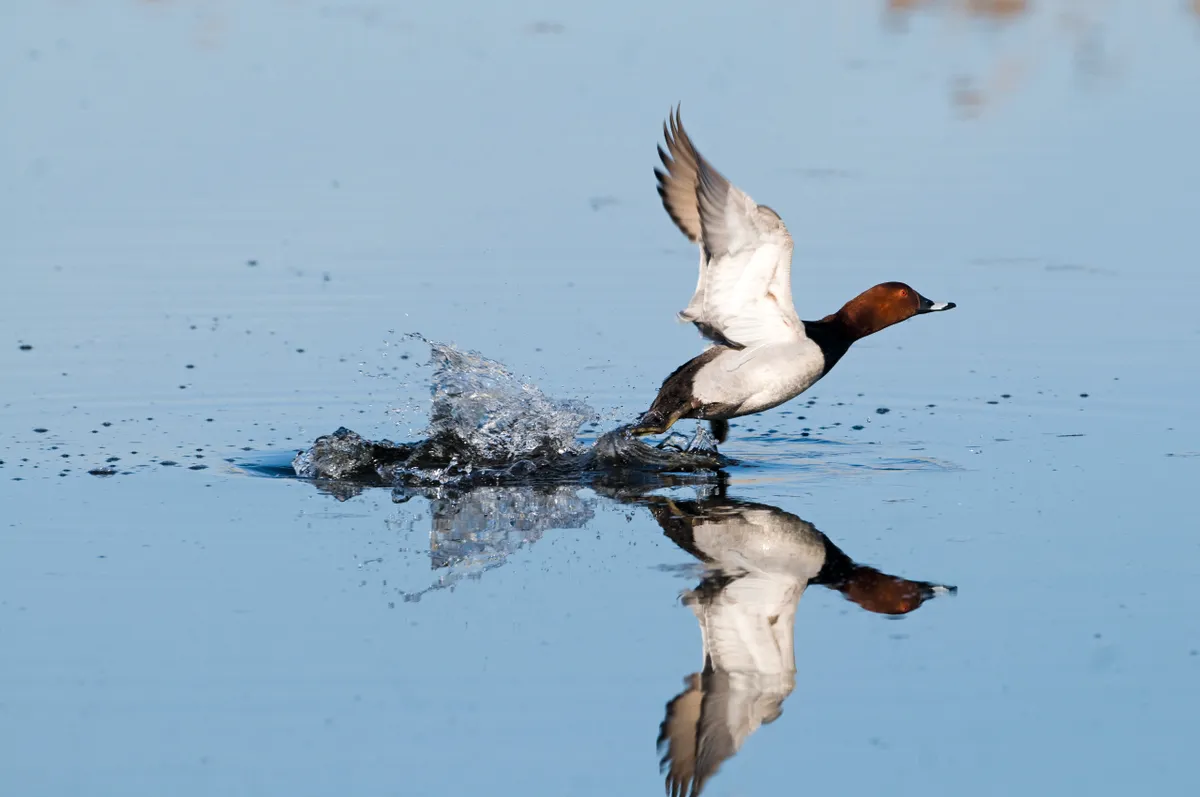
Though pochards breed here, mainly on eastern England’s lakes and reservoirs and on Northern Ireland’s loughs,
these ducks are primarily winter visitors. How many turn up from November onwards largely depends on weather conditions on the Continent.
The same is true of many wildfowl species: milder winters see birds remain further north and east, while sustained icy spells push flocks south and west. A drake pochard is unmistakable, with his smart, red-brown head. But even the plainer female is easy to identify, thanks to the species’ distinctive sloping forehead.
European hedgehog (Erinaceus europaeus)
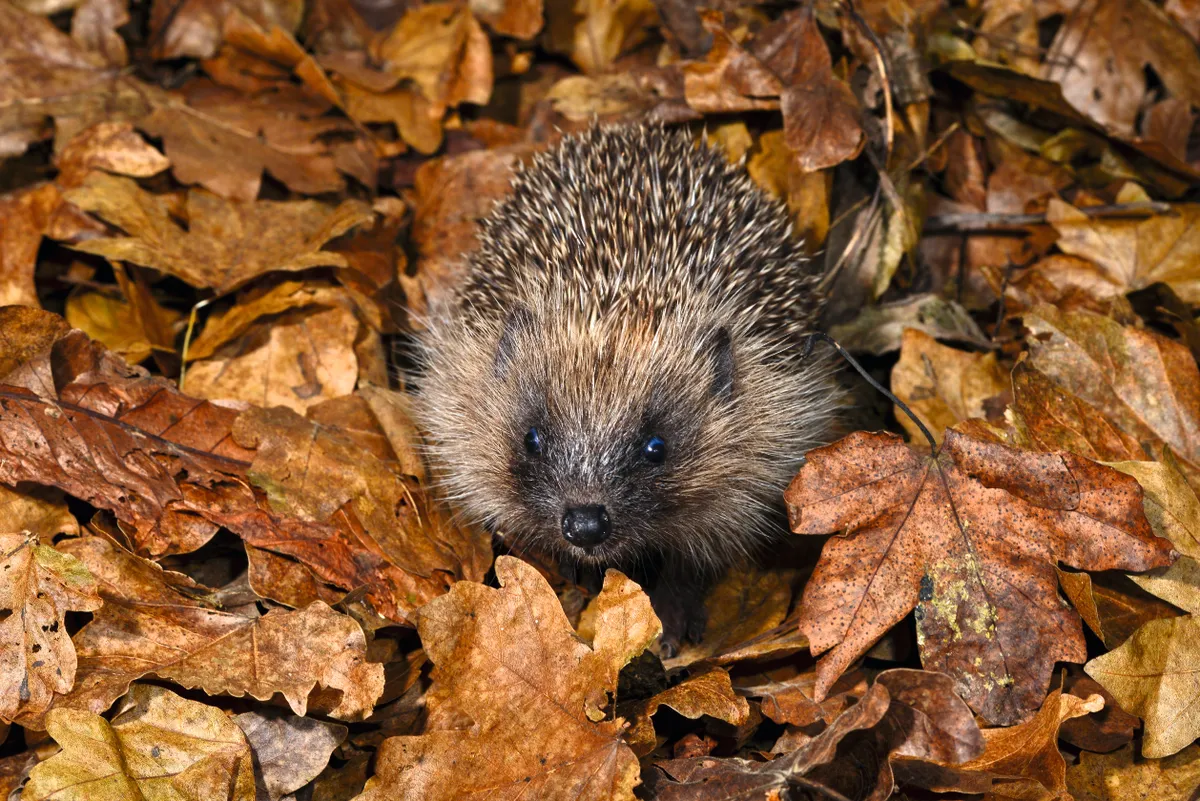
A mix of external and internal cues prompt hedgehogs to hibernate, including longer nights, falling temperatures, waning food supplies and body condition. So, while more hedgehogs are now out and about well into November and beyond, rather than hibernating, it is hard to pinpoint the main reasons.
In 2019, the UK’s Big Hedgehog Map recorded an incredible 846 sightings of active animals in November, up from 354 in 2015. However, Grace Johnson, the popular project’s Hedgehog Officer, cautions that the rise in reports is probably due to greater awareness, rather than a true reflection of increased hedgehog numbers. The impact of warmer winters is fascinating, but complex.
Anyone planning a bonfire this autumn should check it first for hedgehogs and toads that may have snuck inside, ready for hibernation. Better still, put the matches away – both garden and wildlife will benefit if you leave piles of leaves and other clippings to decay. Surveys show Britain’s urban hedgehogs are at last recovering: this has to be the easiest way to help, surely?
Red admiral butterfly (Vanessa atalanta)
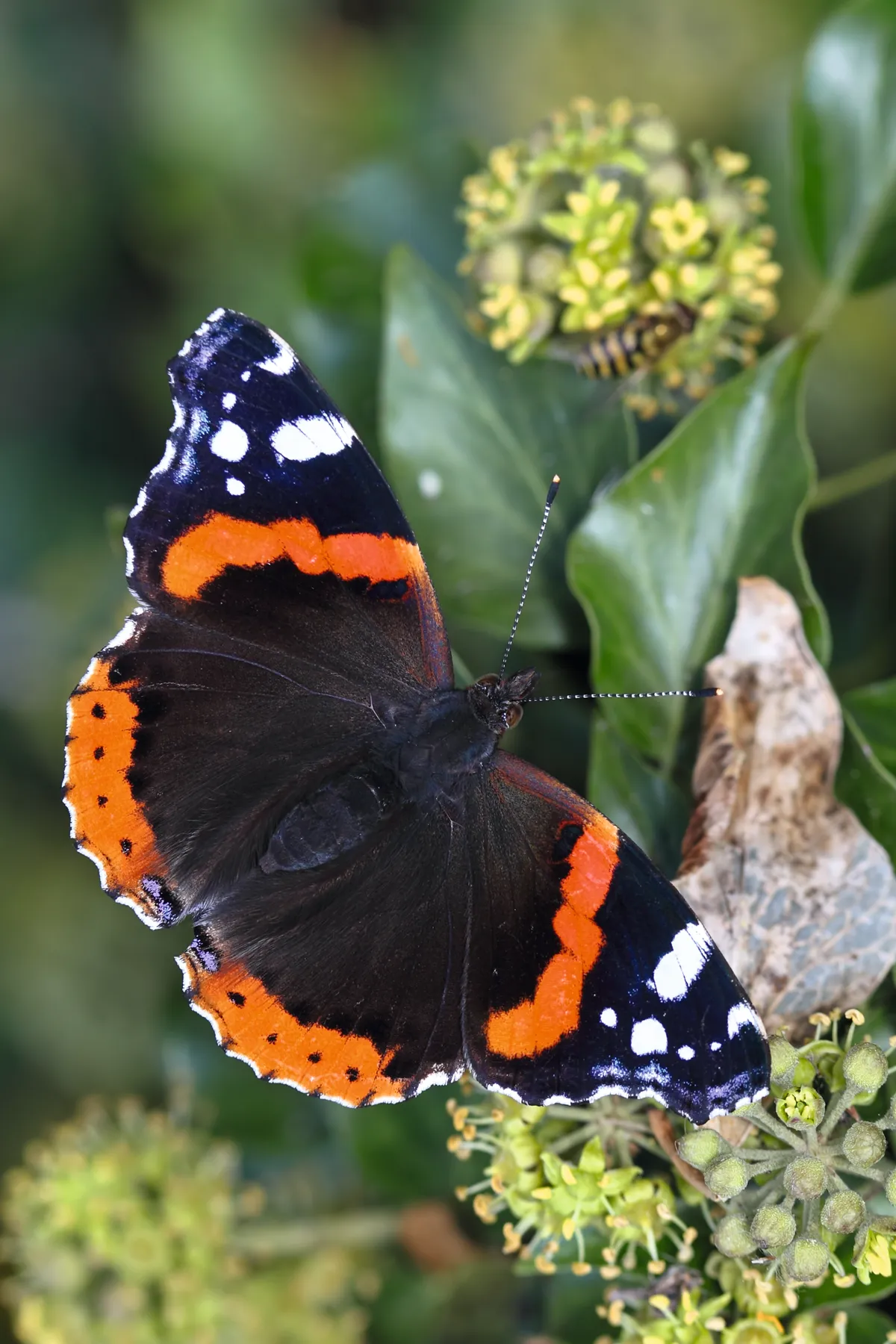
Often the red admiral will be your last butterfly of the year, as well as the first you see the next. It is no longer unusual to see the species active in November, especially in southern areas, perhaps sipping sugar from fallen fruit or imbibing ivy blossom nectar on a tree or garden fence.
For such a common butterfly, there’s a surprising degree of uncertainty whether it can survive entire British winters, as either a dormant adult or caterpillar, or whether it relies on spring migrants to keep the population going.
Aspen (Populus tremula)
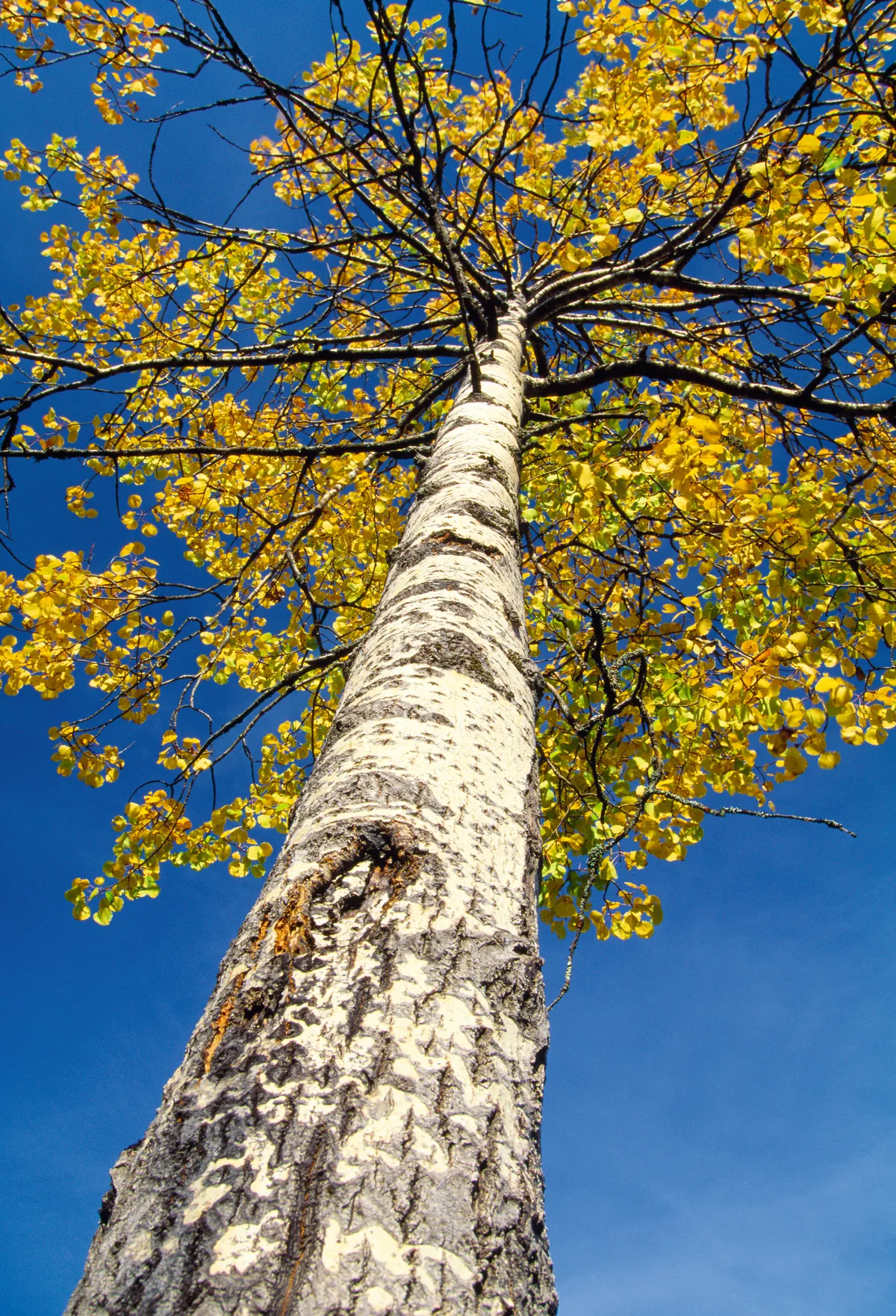
Aspen may be associated with North American forests and Rockies ski resorts, but it is a native (if uncommon) British tree, too. Mostly it grows in the Scottish Highlands, though it is often planted elsewhere because aspen foliage turns glorious yellow or red in autumn.
The leaves famously rustle in the breeze, a beautiful whispering effect produced by the structure of the stems, which are strangely bendy. Aspen looks much like silver birch, and grows in similar places, but it is related to poplars and willows.
Bay bolete (Boletus badius)
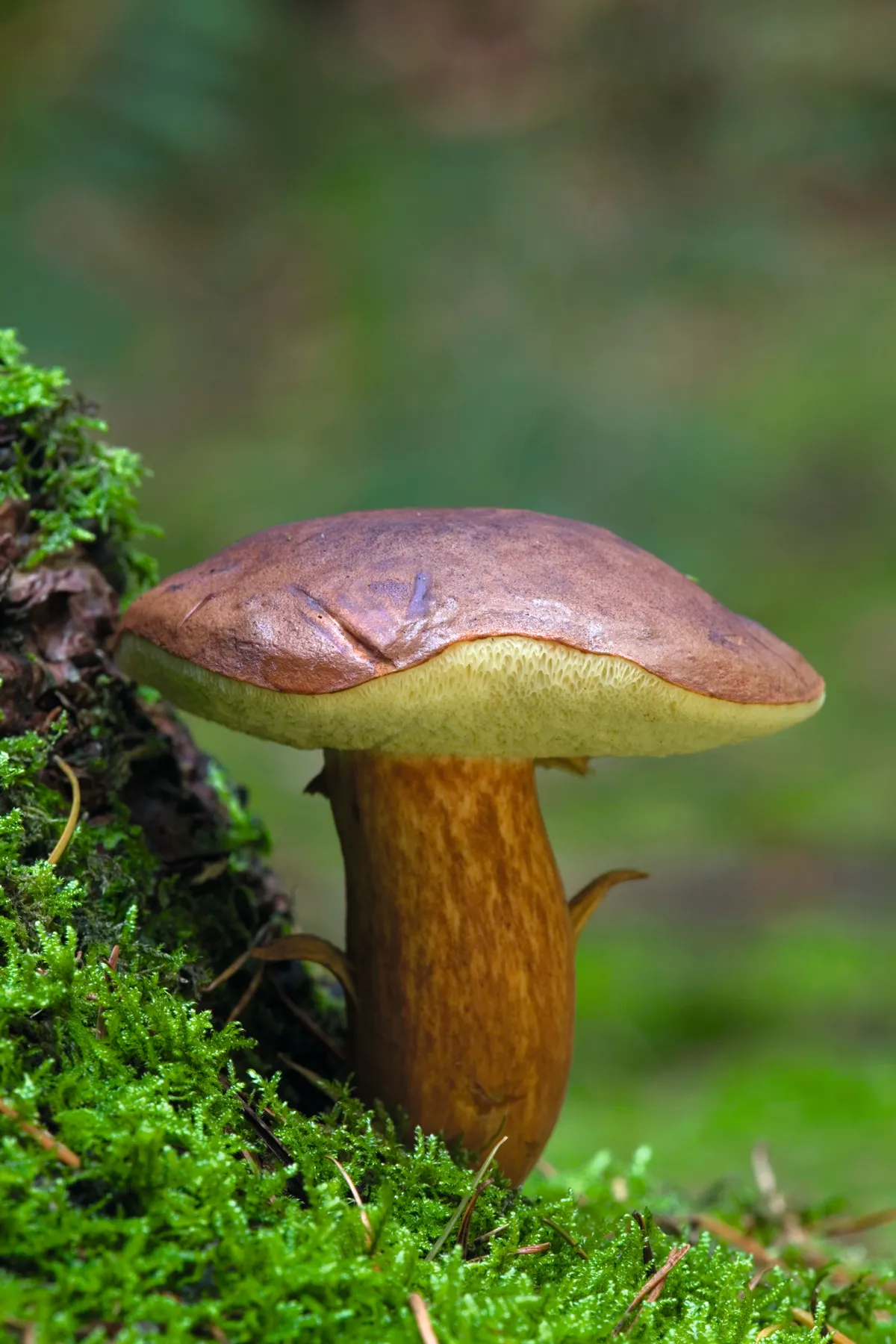
You know it’s time to explore the woods “when the air is sweet and winy with decay”, says Helen Macdonald in her new essay collection, Vesper Flights. A dank November sees all manner of fungi erupt into view, and woodlands – with their plentiful soggy leaf litter and rotting wood – host more species than any other habitat.
Many are tied to particular trees or soil. The bay bolete, however, appears in both coniferous and mixed woodland. Look for the chunky mushroom under pine, beech or oak trees.
Common blackbird (Turdus merula)
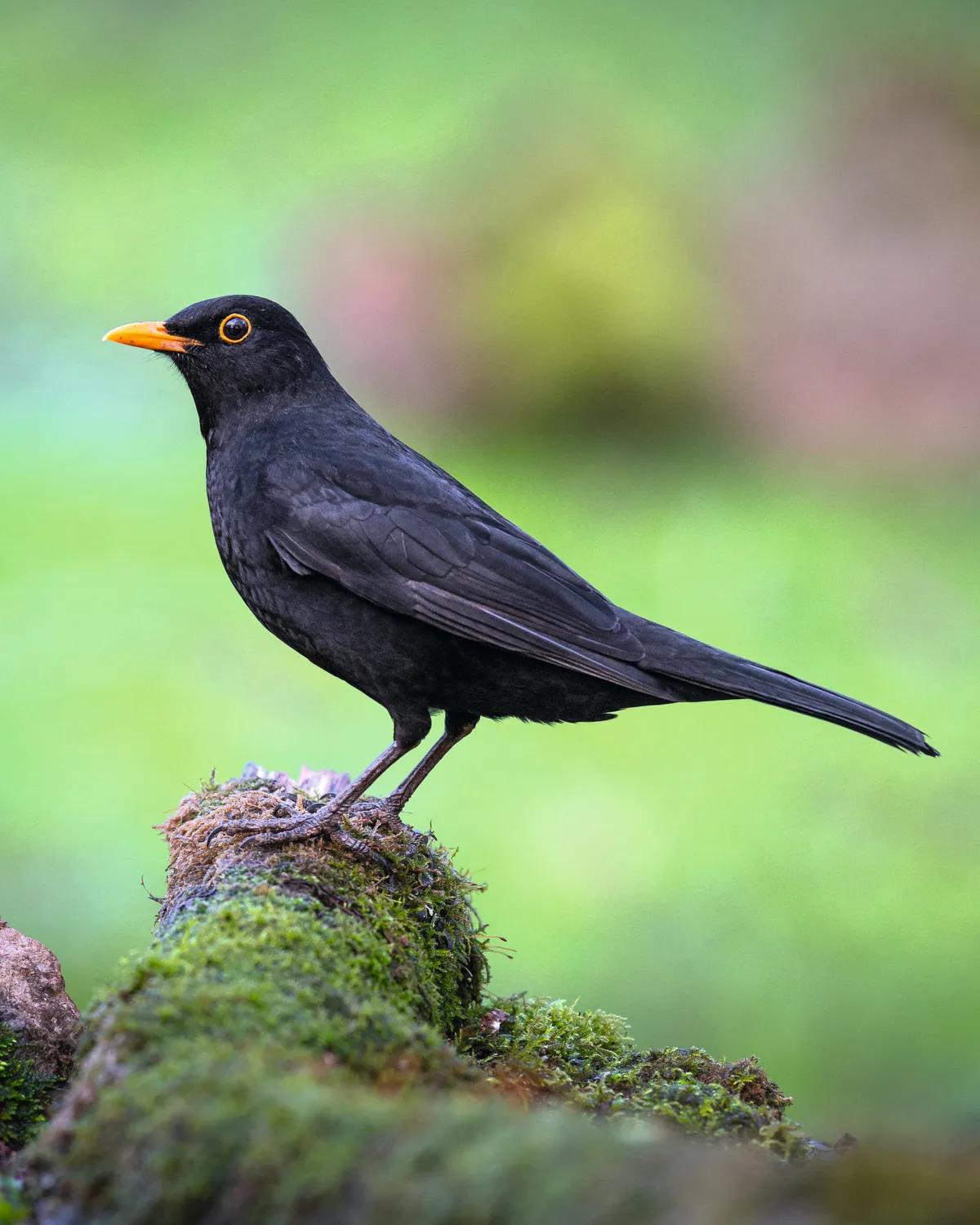
These thrushes don’t half make a fuss while they get ready to roost on autumn and winter evenings. Parents of young children may smile in recognition as the birds chase each other around the garden, worked-up and calling repeatedly. Here a ‘jink’, there a ‘jink’, everywhere a ‘jink, jink’. The rumpus continues until it is almost dark.
At this time of year, you can’t be certain that these or any other blackbirds are ‘yours’, as large numbers arrive from Scandinavia and eastern Europe to winter in the UK.
Learn more about blackbirds and thrushes:
Common beech tree (Fagus sylvatica)
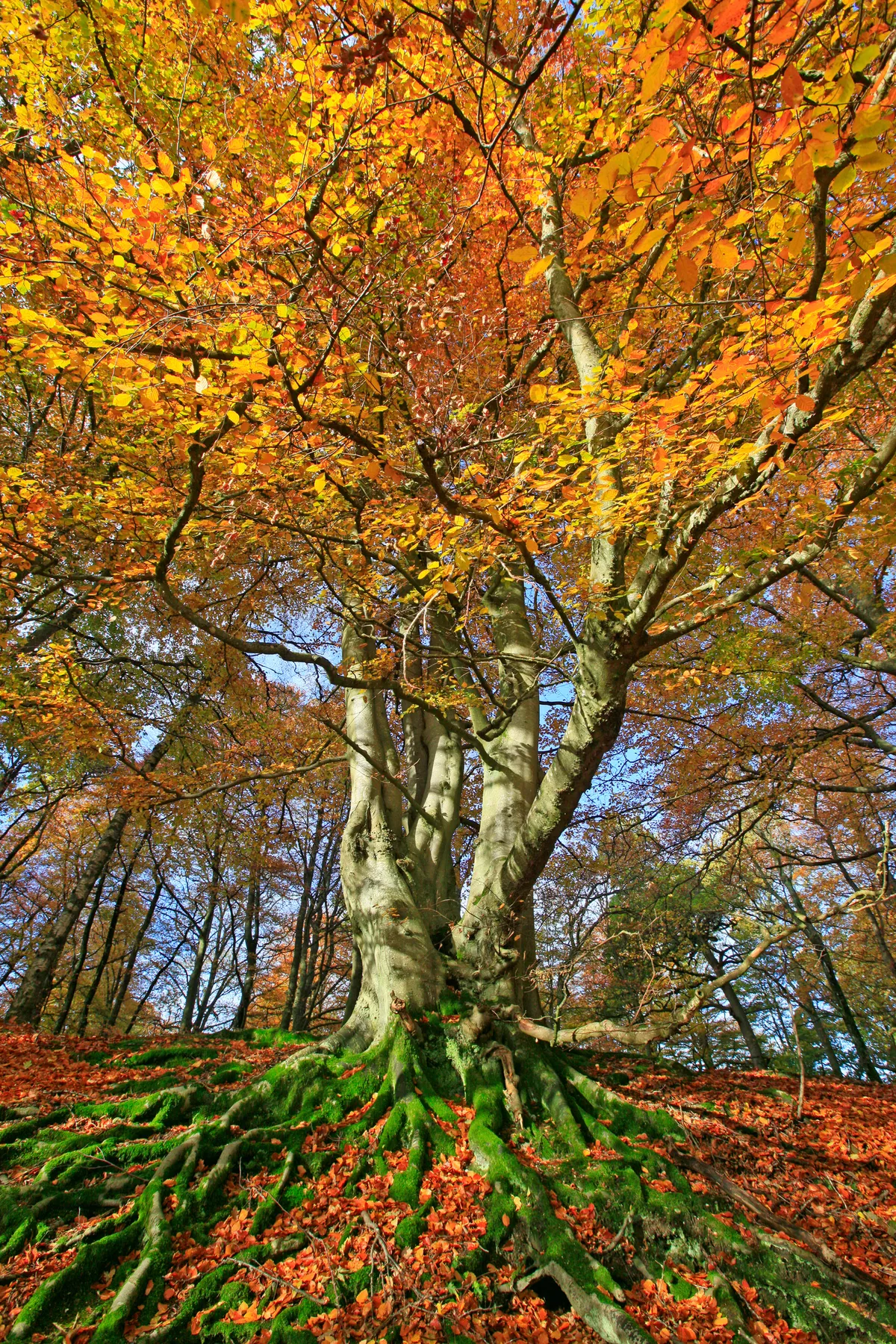
Thanks to two bestselling books – The Hidden Life of Trees by forester Peter Wohlleben, and Richard Powers’ Pulitzer- winning eco-novel The Overstory – the idea of trees as complex, sentient beings has firmly taken root. We no longer think it outlandish that they send chemical messages to one another. But this notion isn’t new. Trees talk in Enid Blyton’s evergreen classic The Faraway Tree, published almost 80 years ago, and many much older stories celebrate their power.
Autumn is a great time to commune with trees – when temperatures fall, the seasonal transformation of our deciduous woodlands can be dramatic. Traditionally, the optimum period for leaf-peeping was October to early November, with displays of gold and bronze beginning in the north then moving south. Climate change means the spectacle is now best enjoyed throughout November and sometimes well into December. Beech trees, pictured here, are among the first to turn.
Leaf-peeping is good for us. In a Forestry England study, 97% of people surveyed said that looking at autumn colours lifts the mood. So what are you waiting for?
Brown-lipped snail (Cepaea nemoralis)
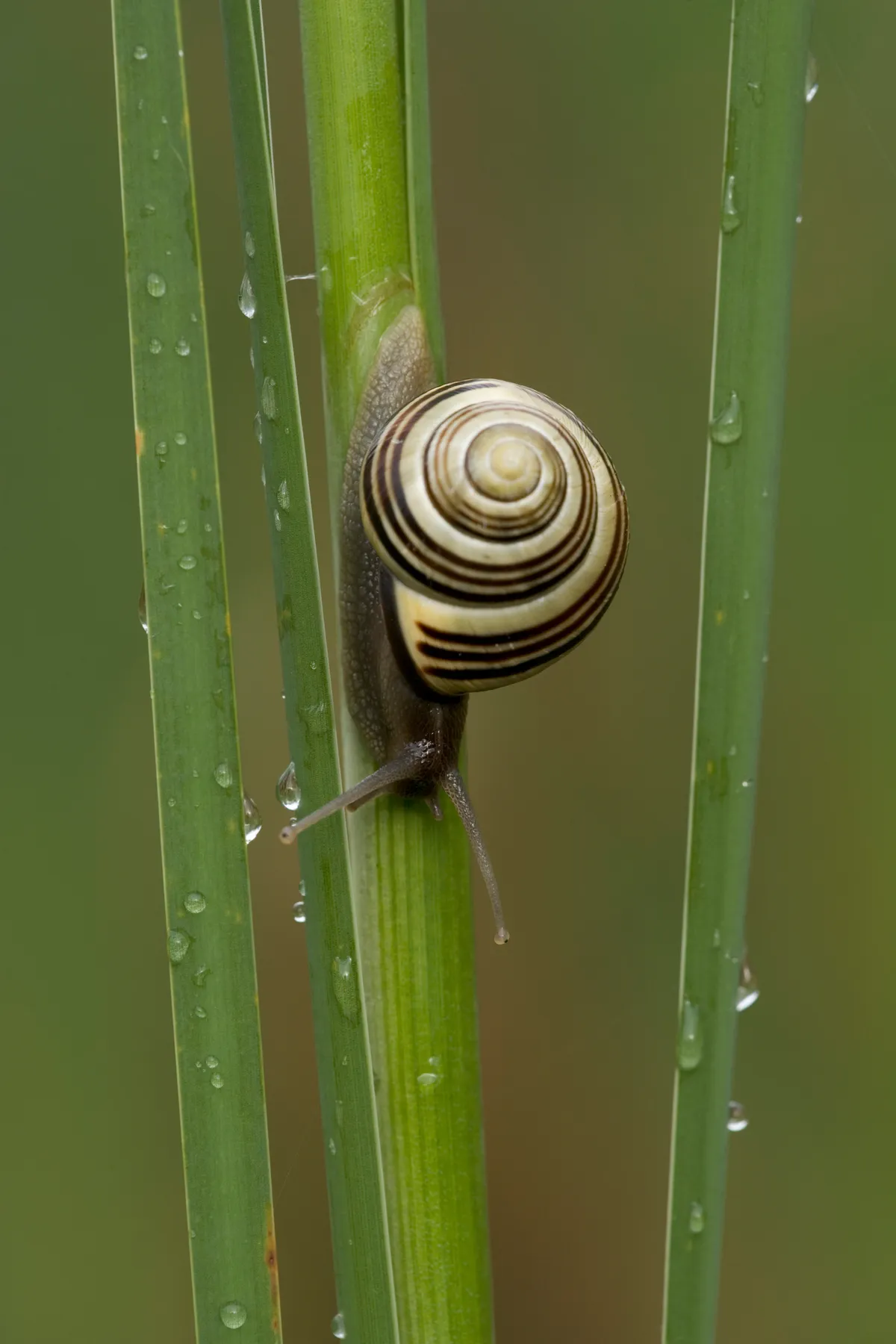
“When I see snail trails,” writes Paul Evans in his book How to See Nature, “I am reminded of the artist Paul Klee’s idea that drawing is taking a line for a walk.” Sliding on mucus is a convenient but costly way for gastropods to get around – a snail spends a third of its energy producing the slippery substance.
At this time of year, snail slime also has another vital function: sealing the shell opening to stop the animal inside drying out while it estivates (shuts down) until spring.
Bracken (Pteridium aquilinum)
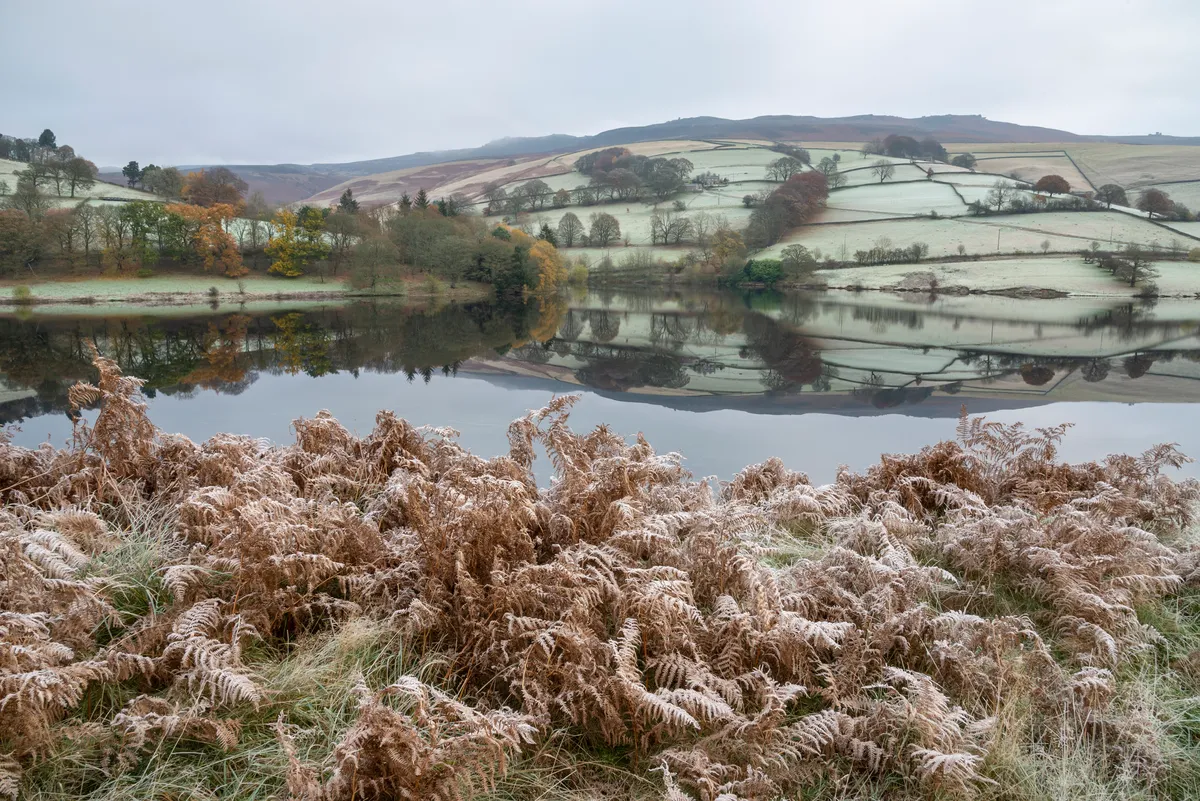
Most ferns stay green all year, but bracken dies back in autumn, turning woodland clearings, commons and hillsides into a sea of yellow and burnished copper. The latticework of its fronds looks fabulously atmospheric when glistening in the first frosts – a popular subject for photographers.
Dry bracken was once widely harvested as bedding for livestock, as a fire-lighting material and (in an age before polystyrene and bubble-wrap) for packaging. Today, several enterprising schemes convert this vigorous native fern into biofuel.
Brown hare (Lepus europaeus)
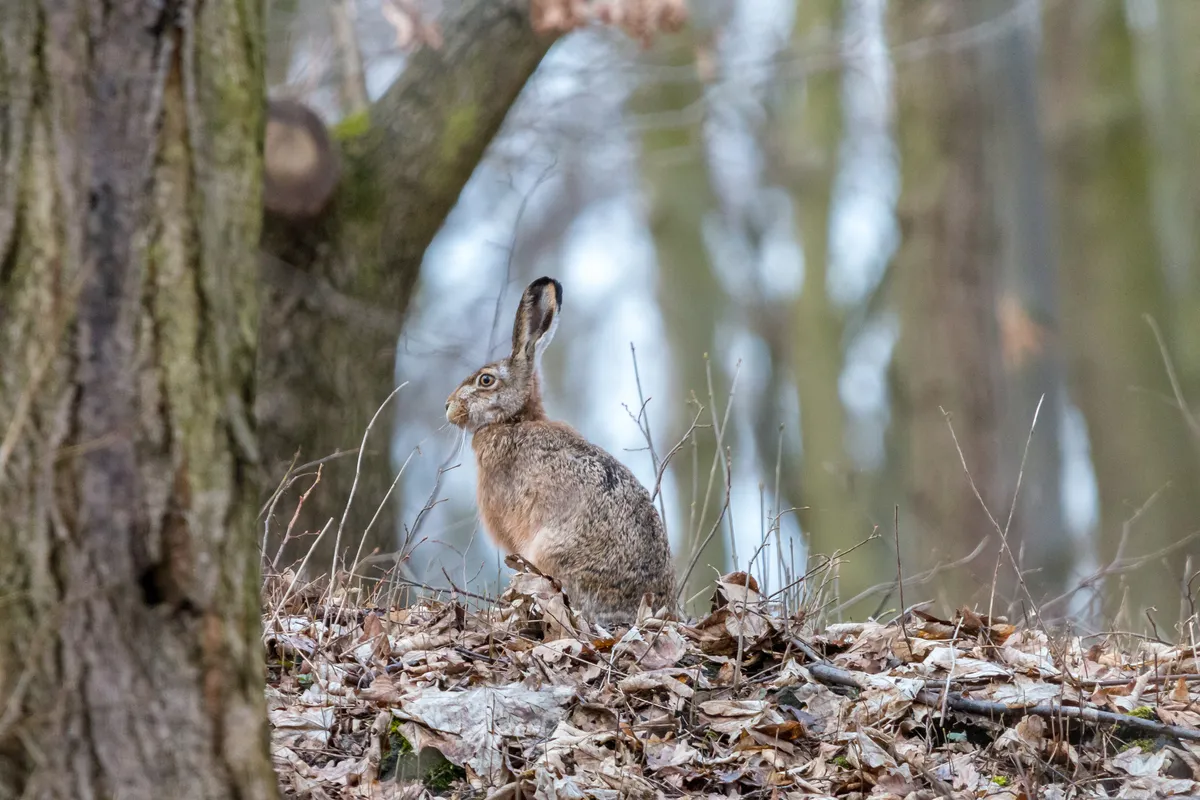
Classic hare habitat is ‘big sky country’ – exposed landscapes such as arable fields, chalk downs, upland pasture and coastal marshes. However, as winter approaches, hares also seek whatever shelter they can find, often entering the edges of woods. They will lie up in cover by day, but venture out in the evening to feed. Hares have a surprisingly wide diet, which at this time of year can include woodland vegetation, twigs and bark.
Like rabbits, they practice ‘refection’ to extract every ounce of nutrition from their food, immediately consuming their soft droppings to redigest them.
Slime mould
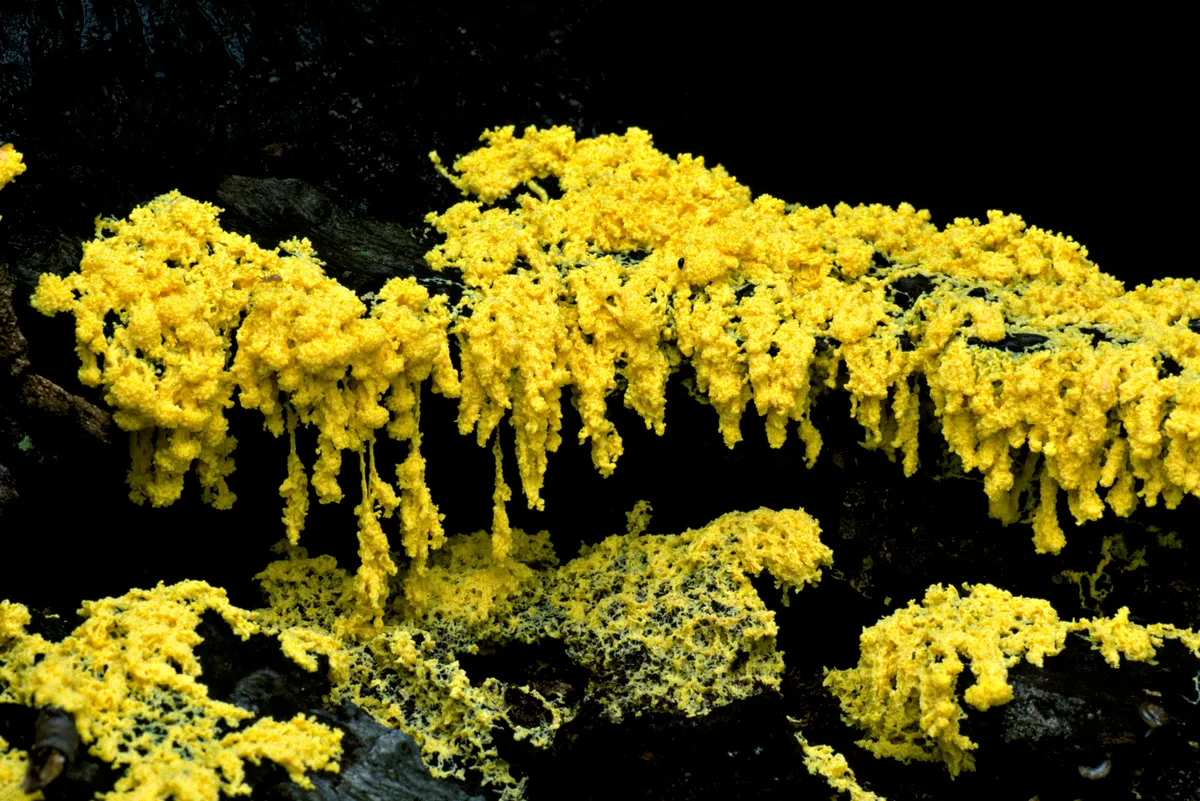
Neither plant nor animal, slime moulds used to be thought of as fungi, but are now classed as their own group of single-cellular organisms. They love damp autumnal woods and often form gloopy mats or mounds on wet leaf litter, logs and tree trunks.
Some species look like bright splashes of paint, though a few unfortunately resemble vomit. Don’t be put off – slime mould is fascinating. One species is grown in labs so that engineers can study how it spreads in search of food, in order to help them map the most efficient rail and road routes.
Common woodpigeon (Columba palumbus)
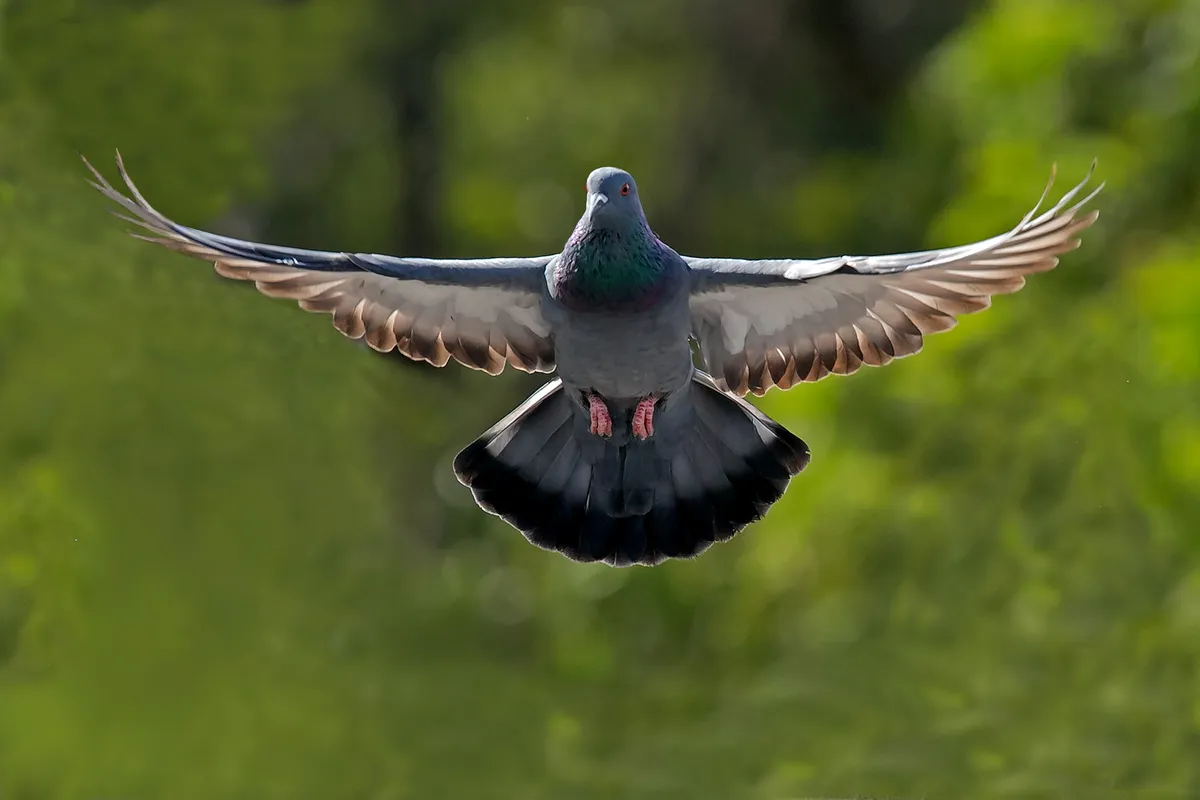
Woodpigeons are among the few British birds that can be identified just by the sound of their wings, and are able to breed in any month. Enormously boosted by modern farming – winter wheat and oilseed rape sustain them during what were once leaner months – ‘woodies’ are so abundant that to many farmers they are pests, while birdwatchers overlook them.
But even common species can hold mysteries. We still don’t know exactly where the huge flocks of woodpigeons migrating south in autumn are heading.
Learn more about pigeons:
Grey seal (Halichoerus grypus)
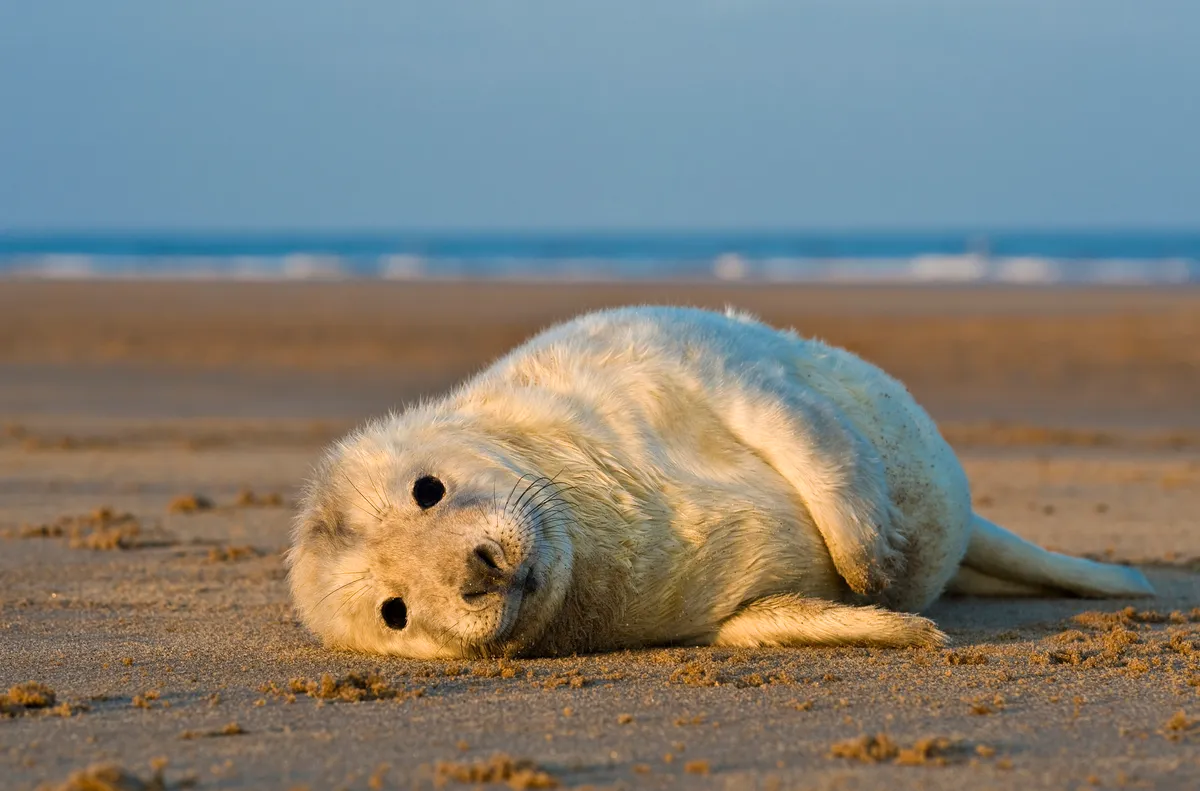
Juvenile grey seals were in the news recently when research showed that captive seals could copy human speech and singing. In the wild, meanwhile, their wails and moans reverberate along rocky shores in November – the height of the breeding season.
Newborn pups have a fluffy, white babygrow but moult out of it in only two or three weeks. They pile on the pounds with their mother’s milk, which is up to 10 times richer than either human breast or cow’s milk.
Yellow-necked mouse (Apodemus flavicollis)
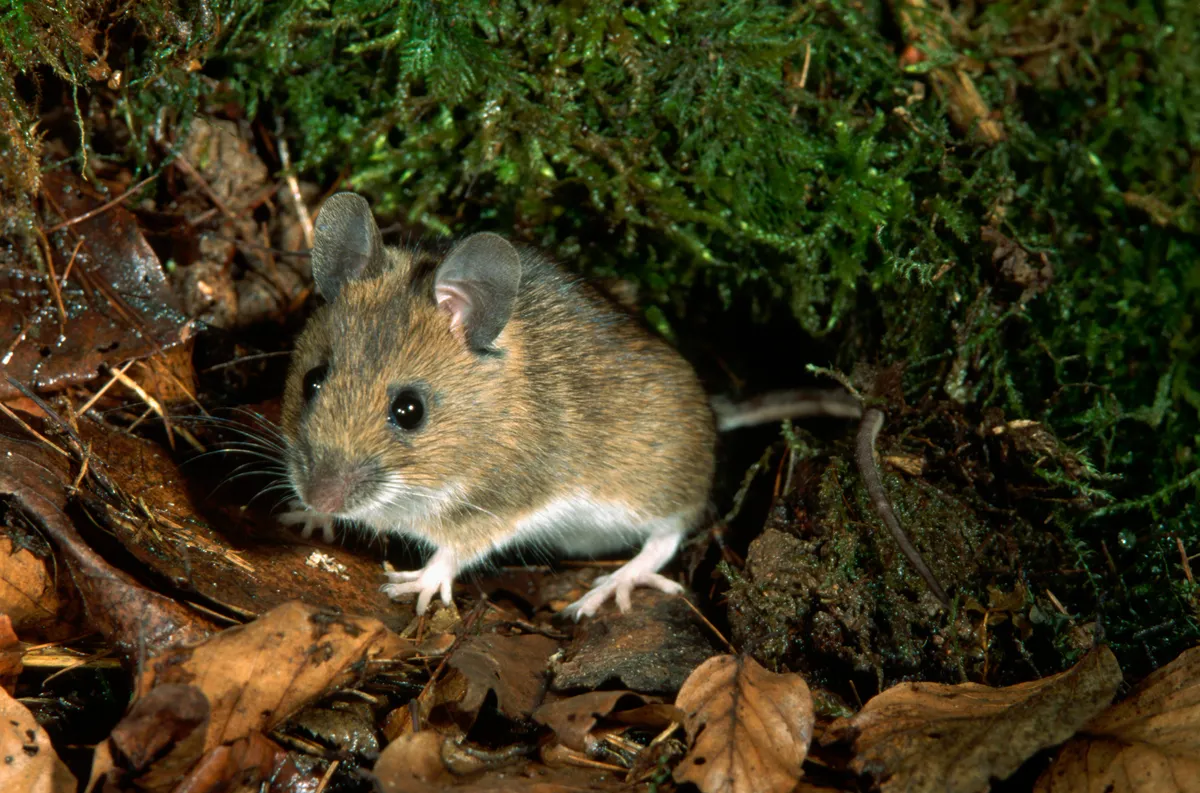
Few, even wildlife lovers, have heard of this wood mouse lookalike. Apart from its band of tawny chest fur, seen clearly only at very close range, the species resembles its more-common relative, but its range and behaviour are somewhat different. Yellow-necked mice occur patchily in southern England and Wales, north through the Welsh Borders to Staffordshire. They’re also more arboreal than wood mice, spending much time foraging in hedges and trees. At this time of year you might hear them scampering around their nests in lofts and sheds.
Learn more about rodents in the UK:
Whooper swan (Cygnus cygnus)
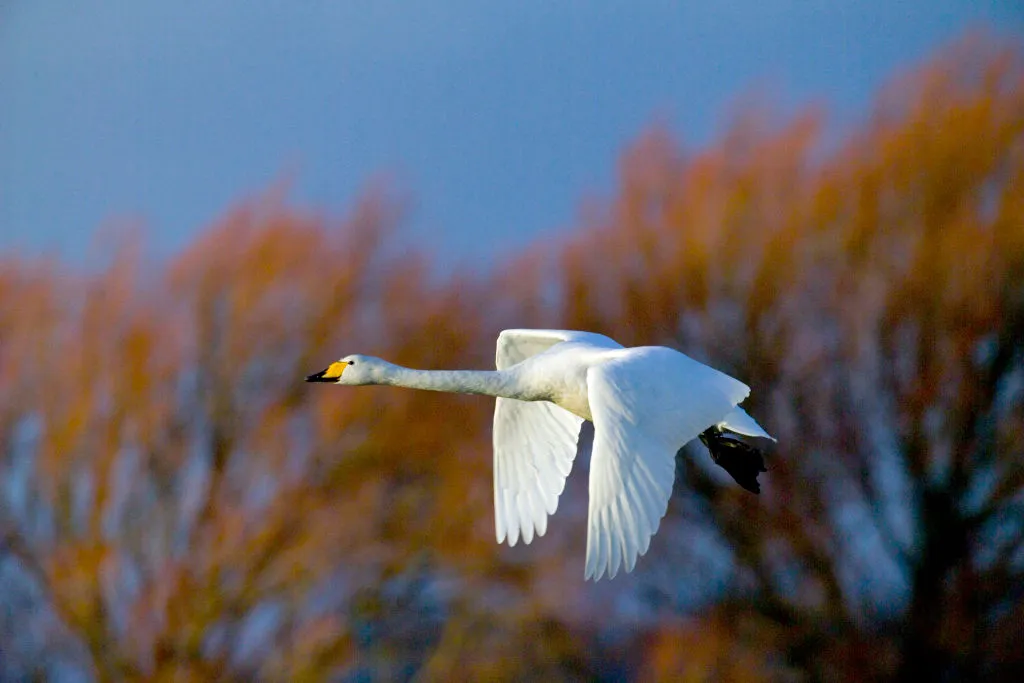
Peter Scott noted in his 1980 book Observations of Wildlife that the breeding grounds of British and Irish whooper swans were a mystery. “We favour the Scandinavian/Russian theory,” he mused. Ringing has since shown that our wintering population is Icelandic. After an epic flight lasting 12–13 hours, close to the limit for such heavy birds, the ‘super whoopers’ make landfall in western Scotland and Ireland in late October or November. Then soon head on to favoured wetlands, trumpeting as they go.
The whooper swan is an example of a tautonym, where the genus and specific names are the same.
Common juniper (Juniperus communis)
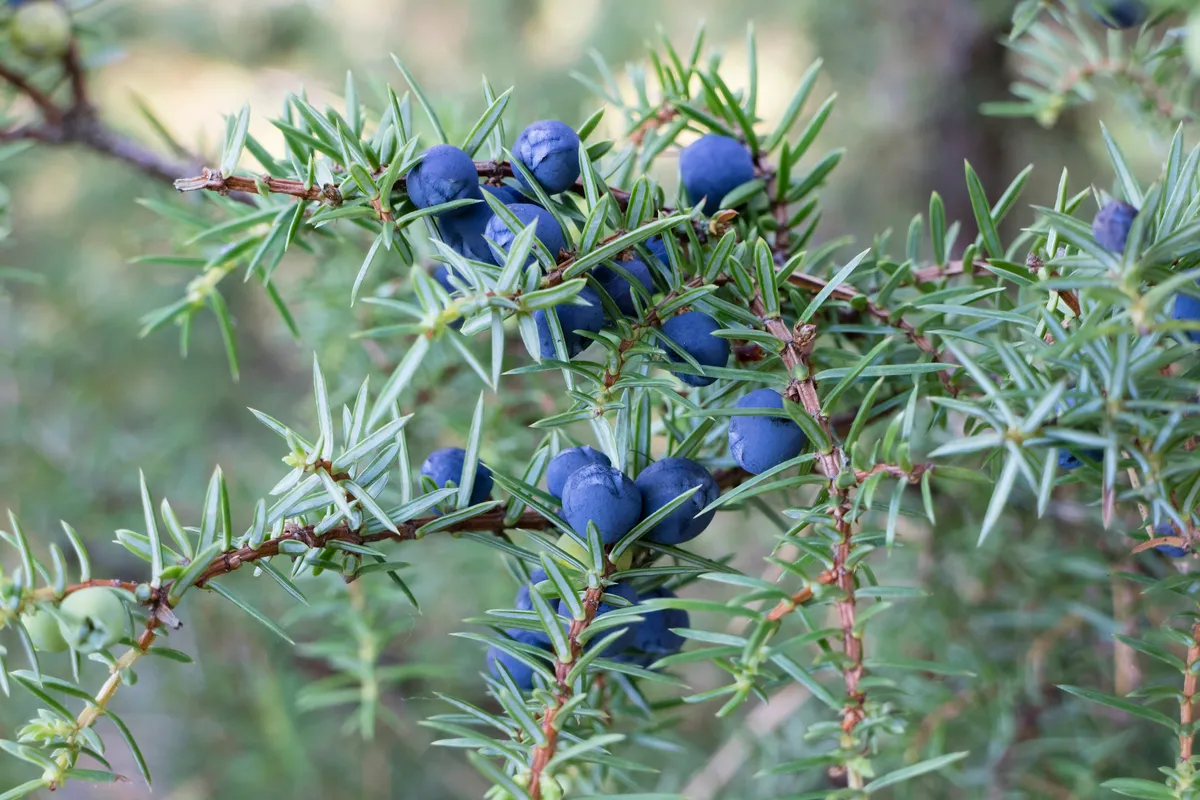
The current craze for artisan gin has, ironically, coincided with a decline in the wild plant whose ‘berries’ (actually fleshy cones) provide the flavour. Juniper is among the most ancient trees in the British Isles, having colonised quickly after the end of the last ice age. It is one of just three native British conifers, the others being yew and Scots pine.
In recent decades, juniper has fallen victim of overgrazing by sheep, deer and rabbits, which strip out seedlings. Conservation projects are underway in its two strongholds: uplands in the north, and chalk downs in the south.
Redwing (Turdus iliacus)
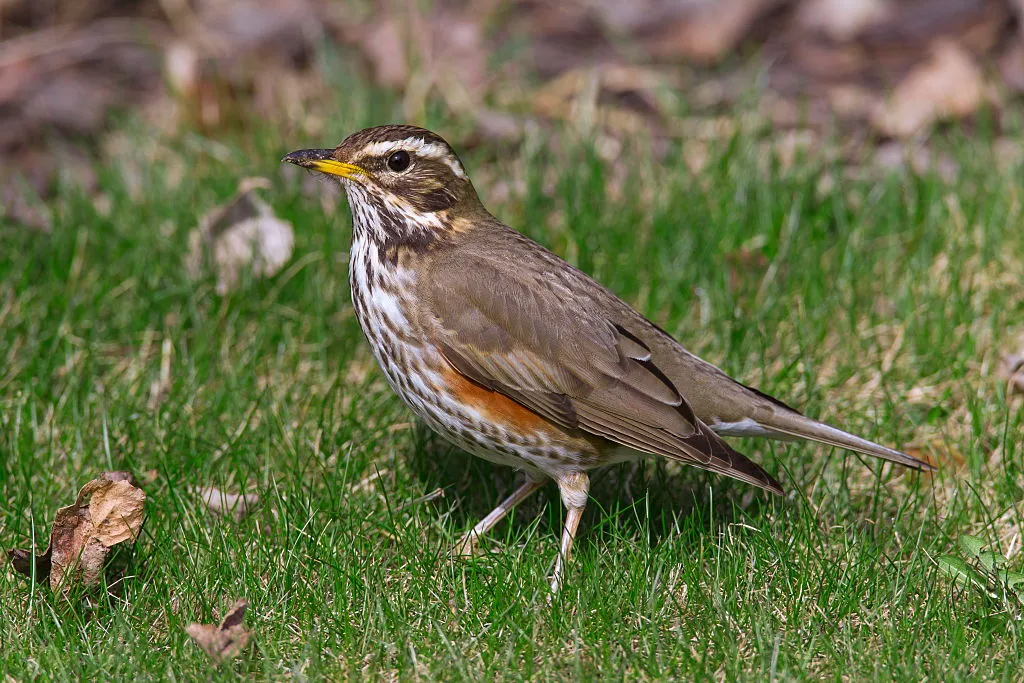
No natural sound is more redolent of autumn than the ‘seep seep’ of migrating redwings passing overhead at night – contact whistles that help flocks to keep in touch. They have a thin, reedy quality, so at ground level the effect is of half hearing something above you in the darkness (listen at xeno-canto.org).
Redwings pour into the UK in their tens of thousands from Iceland, Russia and Scandinavia, staying until March. Despite the name of our smallest species of thrush, it is the creamy markings on the head that first catch the eye.
Learn more about redwings and thrushes:
Hornbeam (Carpinus betulus)
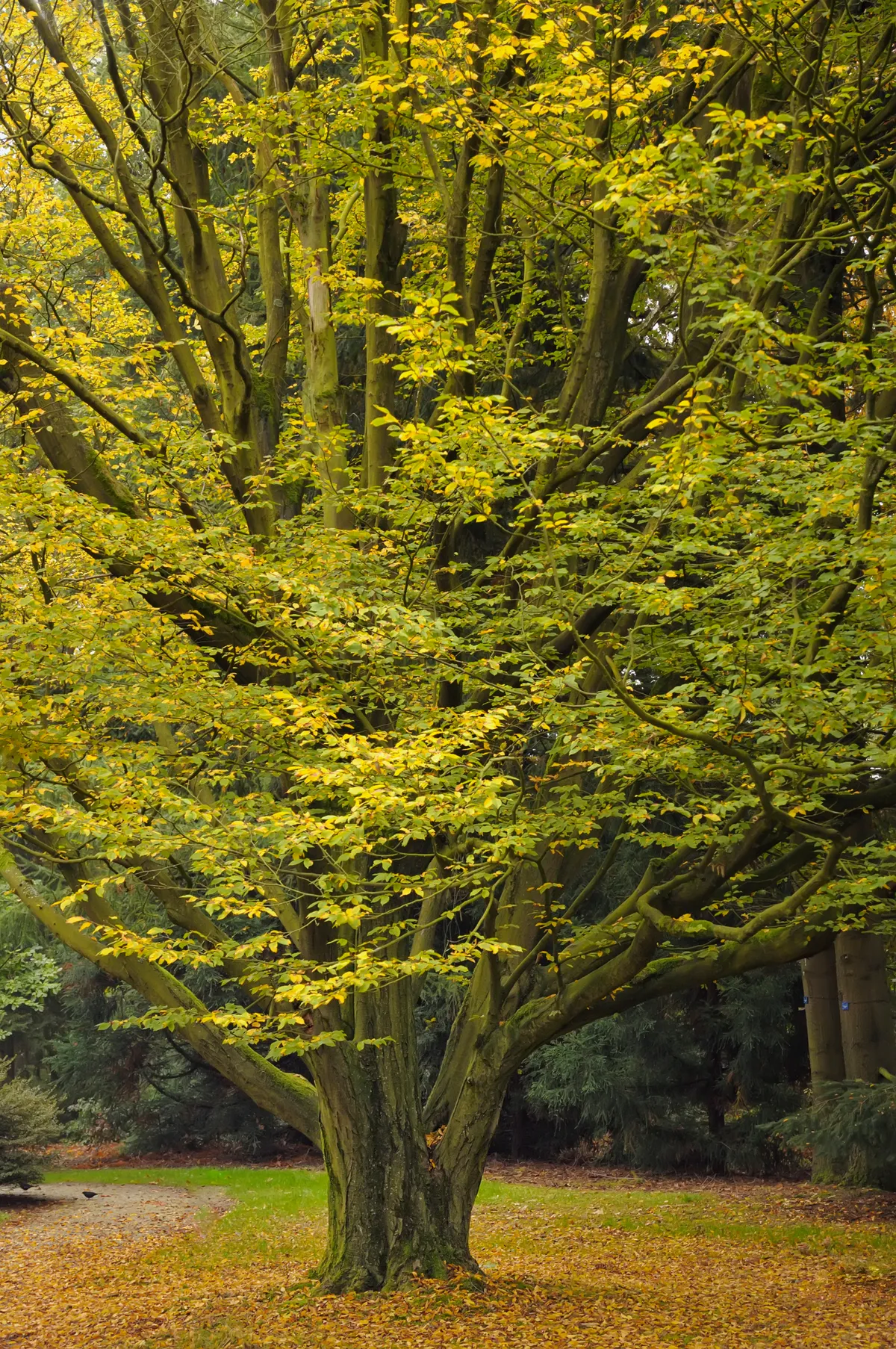
One of Britain’s most overlooked native trees, hornbeam is frequently mistaken for beech. Its oval leaves are smaller, with deeper veins. But the clearest difference is the dangling clusters of papery winged fruit.
Like beech, hornbeam was traditionally pollarded to encourage new growth. It’s found mainly in south-east England and East Anglia; Epping, Hatfield and Hainault forests are famous for their many veteran pollarded specimens.
Dog whelk (Nucella lapillus)
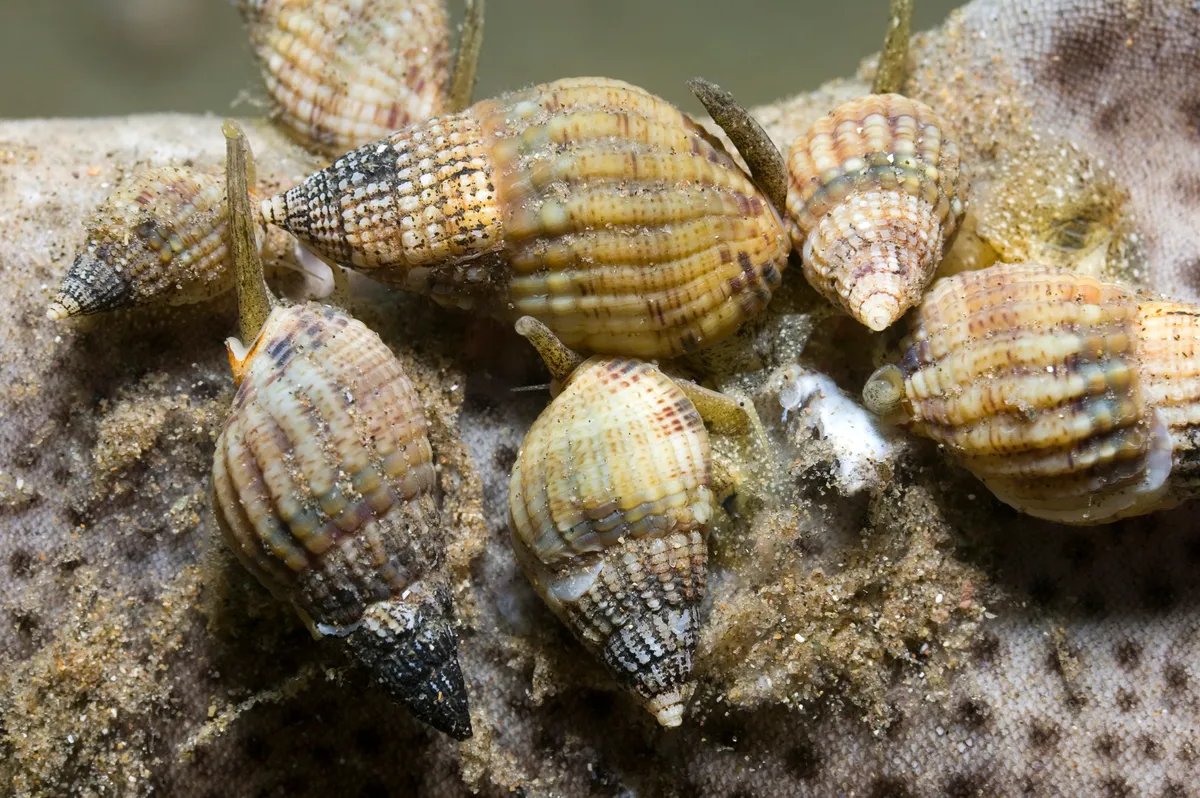
Folklore dictates we should only collect mussels in months with the letter ‘r’. Dog whelks don’t take any notice of such niceties. These sea snails target mussel beds year-round, albeit less intensively in winter. Having chosen a victim they drill a hole, pour in digestive enzymes and suck up the resulting soup. Attacks take a few days. If, when beachcombing, you find an empty mussel shell with a neat circular hole in it, you can be sure the occupant met a grisly end.
Learn more about coastal wildlife:
Eurasian wigeon (Mareca penelope)
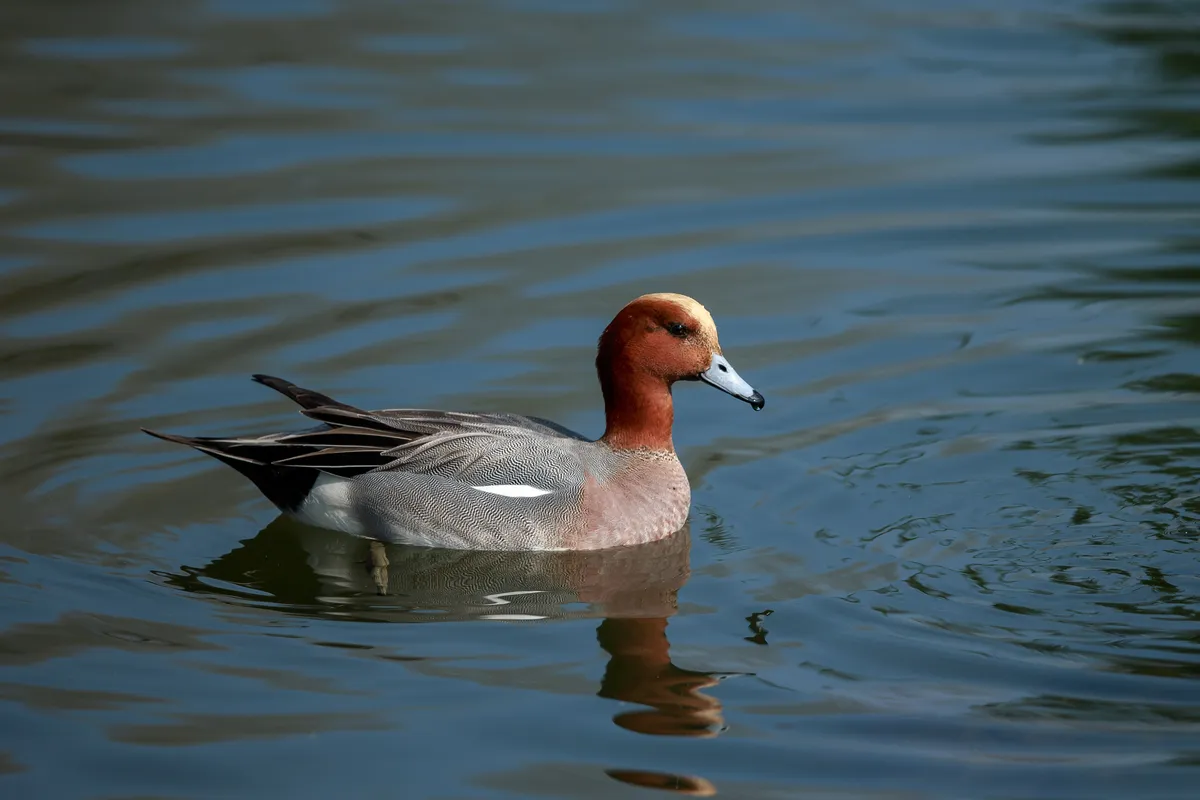
November sees numbers of many duck species swell dramatically, as migrants flock to Britain’s wetlands to escape the harsher winters of the Baltic, Scandinavia, Russia and Iceland. The visitors include over 400,000 wigeon.
Drake wigeon are among our smartest ducks, their plumage a mixture of bold-brush contrasts on the head and subtle grey and peach tones elsewhere. Yet the first thing that draws attention is often a chorus of high-pitched whistles. As nature writer Mark Cocker wittily observed, their gleeful calls have “something of the child down the slide.”
Eurasian woodcock (Scolopax rusticola)
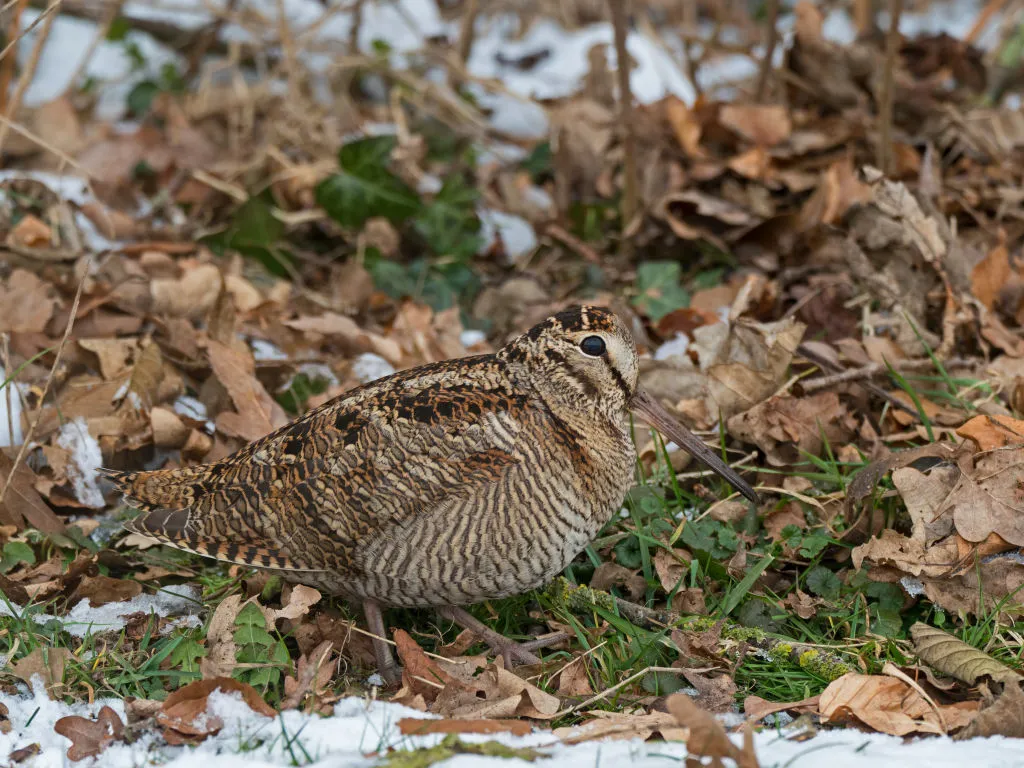
The first full moon in November is said to be a ‘woodcock moon’, as it often coincides with an influx of these nocturnal waders. Tracking studies have shown that they visit Britain from as far away as Siberia and stay faithful to the same wintering sites.
Worm-eaters, they forage in boggy clearings and damp pasture and moorland next to woods. So perfect is their camouflage, your only chance of a winter sighting is if you flush one from its daytime hiding place.
Learn more about woodcocks and other UK waders:
Black bryony (Dioscorea communis)
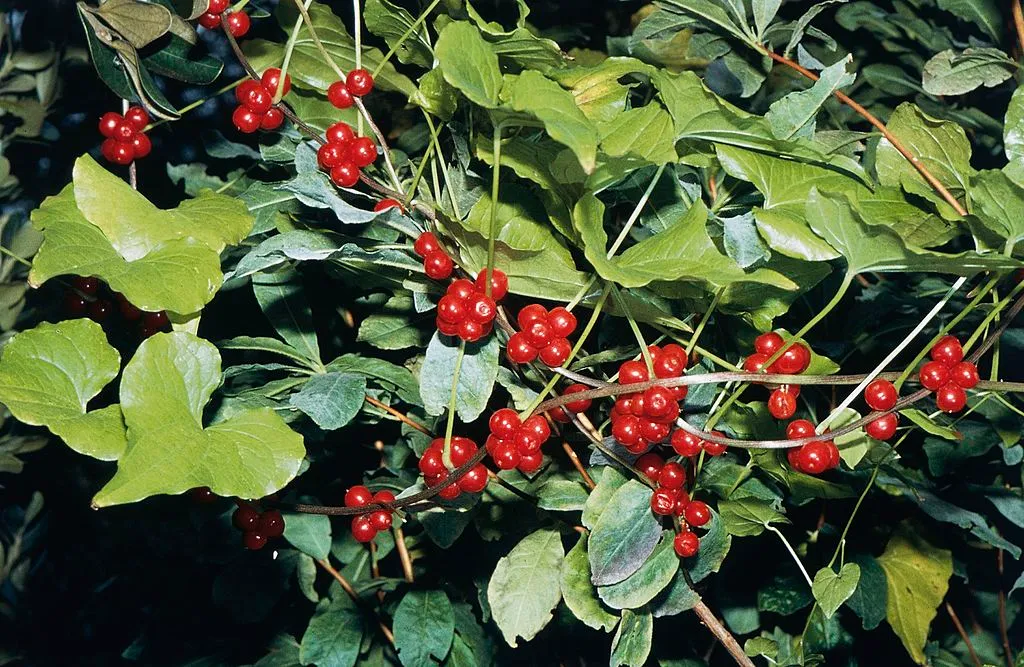
As hedgerow leaves die back in November, the shiny berries of black bryony suddenly become visible, appearing almost shockingly bright among the drab twiggy skeletons of bare trees and shrubs.
“Redder than remembrance poppies, riper than a bunch of tomatoes, poisonous as hell” is how nature writer Paul Evans describes these gaudy garlands in his book Field Notes from the Edge. Black bryony is a climbing, vine-like member of the mostly tropical yam family. But while many yams are important human foods, black bryony is best left well alone.
Learn more about autumn berries:
Oak bracket fungus (Inonotus dryadeus)
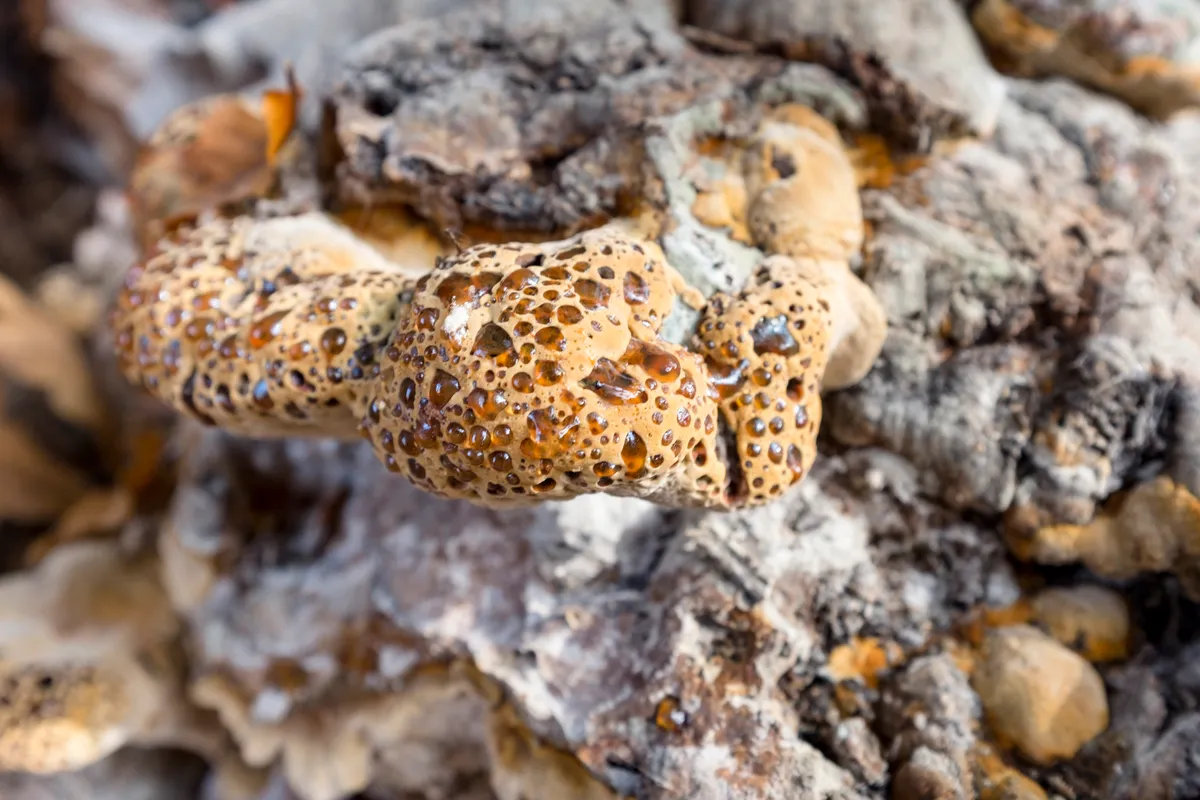
When it comes to fungi, some trees make more attractive hosts than others. Oaks – especially if decrepid, dying or decaying – are particularly rich in species. Among them are several distinctive bracket fungi.
One to search for this month is oak bracket fungus, which looks fabulous, like oozing bread dough studded with glistening jellied fruit or droplets of honey. It persists well into winter, sometimes in groups of fruiting bodies, usually near the base of gnarly old trees.

